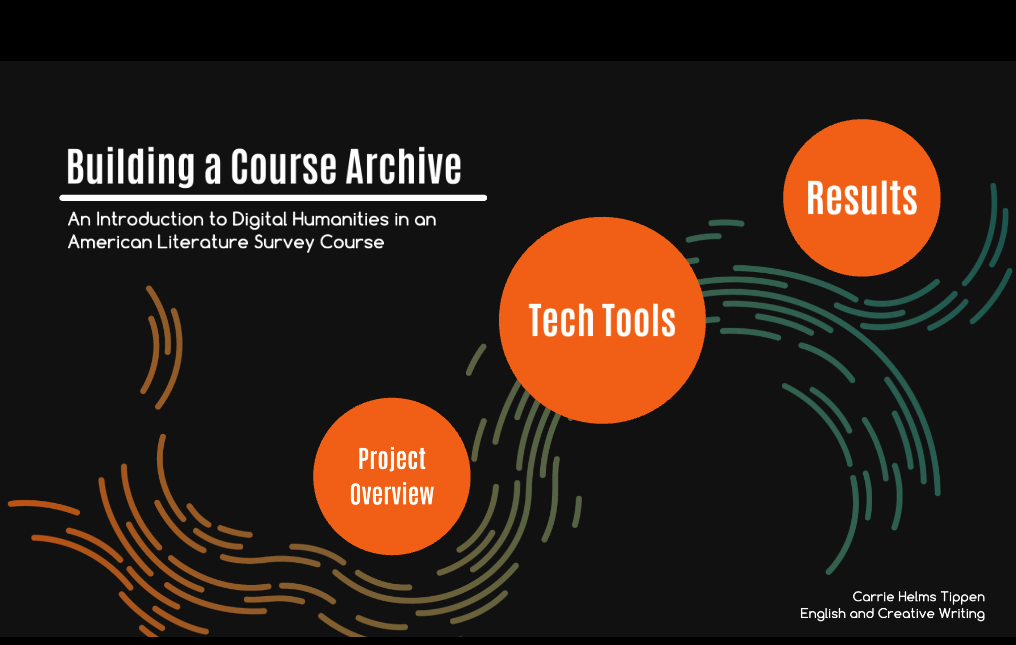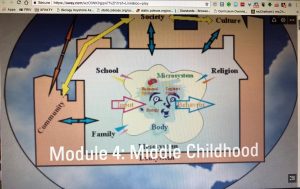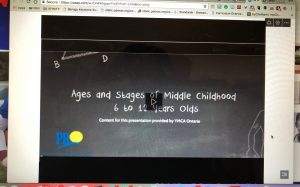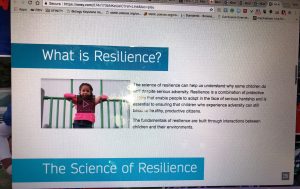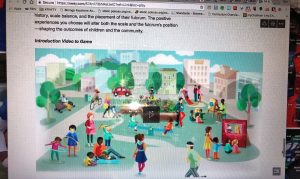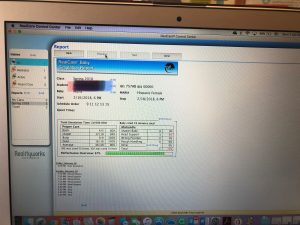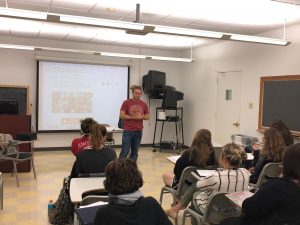Project write-up coming soon!
Author: Admin
Dr. Nataliya Myshakina – Chemistry
Project Overview
Project 1: Use of Turnitin tool in Writing Intensive Course
I used several instruments implemented in Turnitin to help my students to develop their skills in writing scientific reports and reviews.
- Instead of writing a big report after completing laboratory experiment I asked students to submit pre-lab assignment which included scientific background, objectives for the experiment, working hypothesis, and a flow chart of major steps of the experimental procedure.
- Grading checklist/rubric was provided to students as soon as the assignment was posted, so students knew what expectations are, and what I am particularly looking for in their pre-lab write-ups.
- Peer-Review Assignments. As a part of the pre-lab assignment, each student was asked to read the other student’s work and provide feedback on that. To help students to analyze the work of their peers better, I provided students with questions which they needed to answer while analyzing someone’s work.
- Pre-lab graded and feedback was provided to students before they were asked to submit their full laboratory report.
- After completing the laboratory experiment, and discussing various aspects of the experiment in class, students had a chance to make any corrections to pre-lab parts of their reports, and then complete the remaining part of their report with Results, Discussion, and Conclusion sections.
- Grading checklist was provided to students for full lab report assignment to provide students guidance and clarify expectations
Project 2: Use of Problem-Solving Videos in First Year Chemistry Courses
Many students (first year and more senior students alike) search internet sources to watch practice videos on problems/questions solved in class. There are not always suitable or similar examples could be found on Internet, that is why I decided to create my own library of instructional videos which will explain problems/questions very similar to those covered in class and used in tests or exams.
Project Planning
Project 1. First, I re-visited my expectations on lab report assignments. Based on that I have created a general grading check-list for pre-lab assignment and for a complete laboratory report. I considered how typical research article is organized and wanted my students to recognize essential parts of research articles, what information each part contains and be able to write their reports in a similarity to a research article. I also wanted my students to analyze their own work, fix it as needed, that is why instead of one lab report assignment, I split it into two parts. I wanted students to see examples of other student’s work and learn from it, how they can improve their own writing, or be able to see flaws in someone else’s work and suggests ways to improve it. To achieve these I created Peer Review assignments and give students a questionnaire to help them with the analysis. I implemented Bloom’s model of integration, in which students learn information, then they apply that information to write their reports, and last they use their skills to analyze their own work, work of their peers, and suggest or find ways how to improve their work.
Project 2. I have selected topics, which students find particularly difficult, and then selected representative problems for these topics I want my students to see being solved. On the next step, I learned how I can record the videos and share those videos with my students via the course Moodle page.
Project Implementation
Project 1. I didn’t have any big difficulties with this projects, except some small technical Turnitin settings which I needed to set up in a particular way, so my students will have an excess to grading checklists on time or be able to access their peer’s assignments for review.
I didn’t actually have plan B, since the actual use of technology was outside of the classroom, not limited by the class period, and I had time and flexibility to adjust some project aspects.
For example, at the beginning of the semester when I still learning Turnitin, I choose wrong settings for Peer Review assignment and students could not access the assignment on time. As soon, as I learn it, I extended the assignment due date to give students sufficient timeframe to complete the assignment.
Project 2. I did have some technical difficulties here. First, was the clicking noise of Apple Pencil which appeared very destructive on recorded videos. Use of external microphone helped me to overcome this issue. Next, was the choice of application which will provide the right canvas for writing with the iPencil. I have tried a few different applications and found GoodNotes be the most convenient for what I was planning to do. Last, but not least, was the way to record videos and share them. First, we planned to use Zoom, but after a few trials with Becky, we found it difficult to use. We tried recording videos using iPad screen recording, and then deposit those videos on Panopto and this worked just fine.
Project Assessment
For now, I have assessed both of my projects only informally. Developing an assessment tool for both of these projects is my goal for next year.
Informal assessment :
Project 1 (CHM340/BIO440 Macromolecules Laboratory, implemented in Fall 2018)
- More reports submitted on time
- Positive student feedback via course evaluations
- Paperless grading allowed for a faster turn out of submitted/graded assignments
Project 2 (CHM107 General Chemistry I and CHM108 General Chemistry II, in progress Spring 2019)
- No assessment yet, plan to compare Final test results from this year to Final results from last year
Project Reflections and Next Steps
Project 1
- I will add more details to grading checklists, make them more specific for each lab experiment
- I will create student’s reflection questionary for the beginning and the end of the semester to help students to identify their goals in the development of academic writing skills in the beginning of the semester and reflect on the achievement of these goals at the end of the semester.
Project 2
- I will continue to expand my library of videos.
- I will work on an assessment plan.
- I will work on ways to encourage more students to watch those videos
Dr. Gina Zanardelli – Counseling Psychology
Project Overview
My goals in tech fellows were to increase student engagement in class and to help students learn more about ways technology can be useful as they pursue careers as mental health professionals.
Project Planning
My classes had several old school, paper-based activities in them. The activities are designed to allow/encourage students to put the activities in their clinical toolbox. In other words, they are therapeutic interventions or tools that students would be able to use with clients if they had access to them. In addition, transition from paper to tech would facilitate sustainability. The activities I use, such as card sorts, become fairly ratty after a few uses, necessitating replacement.
Additionally, by providing students with the technology to use these activities, the student can revisit the activity for themselves and the activities become much more customizable, fitting clients’ and students’ needs better.
When considering Bloom’s Digital Taxomony, the purpose of most of these activities falls in two categories – Applying and Evaluating. First, students are expected to be able to apply the activities, then they are also expected to critically analyze the activities – which clients are the activities appropriate for? What modifications might be useful to make the activity applicable to different groups or individuals? From SAMR’s perspective, this is more augmentation rather than modification. However, I’d like to think that with the increased use of tech in a classroom, some students will be able to engage in Redefinition – using tech to do previously unimaginable things!
Project Implementation
I use a values card sort in my Ethics class. As a mental health clinician, self-awareness is of utmost importance. Clinicians must be aware of their own values and ways that their values can intentionally or unintentionally influence the counseling process. By using a values card sort, students can clarify their own values, then reflect on (through discussion and a paper) ways their values might influence perceptions of clients.
With much assistance from Lauren and Becky, I translated my old paper values into Padlet, which allowed students to sort several values into one of 4 columns:

My plan B was to have a few copies of the paper versions, and paper worksheet at the ready. Padlet provided several ways to share this template with the students, including an option to allow students to remake the template on their own device. I could also email the link to students, embed it in Moodle, or even share it on Facebook (I chose not to do that…for obvious reasons).
Project Assessment
I assessed the project informally. First, most students were able to use Padlet; only 2 of my students were not able to access Padlet via their computers. I’m still not sure why but those students used the old-school paper cards to sort their values. The rest of the students were able to use the Padlet version on their computers (yay for plan B). Most students said they liked it. Two of the students said they would have preferred paper because there was something engaging about actually holding (“weighing” one student said) the values in their hands. The research on online vs. paper reading helps me make sense of this – there is a bit of evidence that pen and paper methods may be associated with better retention, but it is far from conclusive at this point. Personal preference has also been cited in the research: Age and nationally tend to influence preferences (younger students tend to prefer screen).
To me, the project gave all of us (students and me alike) the opportunity to consider personal preferences and reflect on how our clients will have preferences for paper or technology as well. Students came to the conclusion, on their own, that client preferences should be honored and that the Padlet version of the card sort is a little more pleasing to the eye and customizable. But,
Similarly, I am also using Padlet to coherently organize all of our field placement listings for our master’s students. IN the past, I have simply sent out an email with attachments of descriptions of the various internship opportunities in the community. With the brilliance of Lauren, she suggested Padlet. Feedback has been overwhelmingly positive, as the listings are more organized, easier to access, and more aesthetically pleasing:

Project Reflections and Next Steps
I think the projects worked well and I really like Padlet! The downside is for the free account, one can only have 3 Padlets, and now I want to use it for everything! However, there are so many other fantastic tech tools available, I am excited to explore other options.
For my next project (coming up in my class in about a week), I plan to use Google Maps to have students create community asset maps. Another option is ThingLink, but that will have to be for another time.
What I learned:
- I really like using tech and learning about tech to improve teaching!
- For the card sort project and the job announcement bulletin board, I think I have a good thing going. However, getting more formal student feedback is important and will very likely help me make the tools even more user friendly for students.
More generally, I learned that I have to carve out specific time for learning and implementing tech into my teaching. Implementing the ideas can take time and sometimes involves a steep learning curve but Lauren and Becky have been fantastic in providing refreshers as needed and moral support/encouragement (and coffee…thanks!)
Dr. Christopher O’Brien – Psychology
Project Overview
My project incorporated the use of several technologies, Zoom and Padlet, into my Critical Thinking in Psychology (PSY217W) course in the fall of 2018. The purpose of this course is to teach students the skills to engage in critical reading, writing, and thinking as they consume information within the discipline of psychology. This course also teaches students how to engage in scientific writing and adhere to proper APA formatting. In previous semesters, I would often use class time for students to discuss the psychological content they were consuming as well as providing students an opportunity to work on their APA formatting. However, I observed that students would be quite reluctant to either initiate or join in on the discussions. I also observed that students would often struggle outside of the classroom when working on their assignments that required scientific writing and adherence to proper APA formatting. Based off these observations, I concluded that there must be a way to not only increase their participation, but to also improve their performance on writing assignments. After being introduced to Zoom and Padlet throughout our Tech Fellows meetings, I soon realized how these tools could encourage students to be more engaged with the content and discussions, and as a result, improve their performance on APA writing assignments. Therefore, my project incorporated the use of Zoom to capture a recording of my computer as I completed a references section from start to finish while adhering to proper APA formatting. The second technology my project incorporated was the use of Padlet, an online bulletin board, that allows students to post to an online bulletin board in real time.
Project Planning
For both technologies, student accessibility was the factor I initially considered. The Zoom recording was uploaded to the course Moodle page. Padlet is a free app that can be downloaded on smartphones, which every student in the course had. A second consideration was to learn and become familiar with the technologies myself. Having used Zoom before to video conference, becoming familiar with the recording feature of Zoom did not take long. Although I had no prior experience with Padlet, I was able to play around in Padlet during our Tech Fellows meetings. Learning how to use Padlet was a relatively quick and easy process. A third consideration was how to get students to “buy in” and learn how to use the app in class.
A major course learning objective was the development of skills to properly write and format a references section. Creating a video tutorial for how to properly format a references section seemed like an appropriate and salient project. Other major course learning objectives were the development of critical thinking and communication skills. The use of Padlet in class afforded students with low-stake and low-pressure opportunities to practice and hone those skills as responses made in Padlet can be done so anonymously.
While planning the Zoom video tutorial, I integrated two of the twelve principles of multimedia learning according to Richard E. Mayer’s book, Multimedia Learning (Cambridge Press, 2001). The first principle I integrated was principle #5, which is the temporal contiguity principle. This principle states “People learn better when corresponding words and pictures are presented simultaneously rather than successively”. The second principle I integrated was #11, which is the voice principle. This principle states “People learn better when the narration in multimedia lessons is spoken in a friendly human voice rather than a machine voice”. A second model I integrated into this project was Bloom’s Taxonomy. As students first watch the video tutorial, they will be understanding and making sense of the skills necessary for formatting references sections. The end goal of the Zoom video tutorial is to provide students with the skills necessary for creating accurate references sections in the future.
While planning the Padlet project, I integrated several components of the Substitution, Augmentation, Modification, Redefinition (SAMR) model. One component of the SAMR model I incorporated was modification. Using Padlet in the course redesigned the task of communication from the traditional format of a student raising their hand to speak to where each student now has the opportunity to communicate in an anonymous and digital format. Further, Padlet allows students to communicate in ways other than spoken words (e.g., pictures, GIFs). By affording the students to communicate in these alternative ways (e.g., via GIFs), this incorporates the redefinition component of the model. In previous courses that utilize communication, it would have been inconceivable to communicate through such mediums as emojis and GIFs.
Project Implementation
For the Zoom video tutorial project, I recorded a practice run of myself going through the tutorial. Then, I watched this practice recording to pick up on any errors or mistakes I may have made, made sure I was speaking loud enough, not hitting the keys too loud, etc. Once I went through a few more practice runs, I recorded the tutorial that would eventually be uploaded to the Moodle page for the course. After I uploaded the video, I went to the Moodle page and switched my role to ‘Student’. That way, I could see what the student would see and to ensure the video was properly uploaded and could be viewed without issue. Had there been any issues preventing the tutorial from either being recorded or uploaded to Moodle, plan B was to conduct the tutorial in-class with a video recorder capturing the tutorial. That way, a recording of the tutorial would still exist.
For the Padlet project, I first had to go into the app and create a blank bulletin board. The template I chose to work with was a stream. That way, responses to the question could be streamlined in an easy to read, top-to-bottom format. After choosing a stream template, I edited the title to reflect a question, which was “What are your strengths and weaknesses as a psychology student?” Next, under settings, I activated the profanity filter, which replaces bad words with nice emojis.
Next, I sent out an e-mail to students a few days before the class in which we would be using Padlet. In the e-mail I instructed students to bring their smartphones to class and to download the free version of the Padlet app prior to class. In this e-mail I sent out links to download the Padlet app from either the Google Play store or the App store, depending on what kind of phone each student had. Lastly, I embedded the link to the stream template I created in the e-mail. That way, students could easily access the Padlet I created.
In case students experienced difficulties with the app on their phones, plan B was to access the Padlet using their laptops. Fortunately, all students were able to respond and post to the Padlet using their smartphones.
Project Assessment
For the Zoom video tutorial project, I used a formal assessment by grading the subsequent references sections that students would submit throughout the course of the semester. I would argue the assessment is both formative and summative. Formative in the sense that prior to submitting their first references section, students have been introduced to and learned about proper APA formatting. Thus, when submitting their first references section, I am assessing students on how they are learning the material. This project is also summative in that students are submitting references sections numerous times throughout the course of the semester. The expectation is that students are improving on their performances with writing and formatting references sections throughout the semester. Thus, when students submit their final references section, my assessment is summative in that I am evaluating how much they have learned APA formatting over the course of the semester.
For the Padlet project, I used informal assessment. A main objective of this project was to increase student participation during class discussions. To assess this objective, I compared the number of responses to the same question (i.e., “What are your strengths and weaknesses as a psychology student?”)
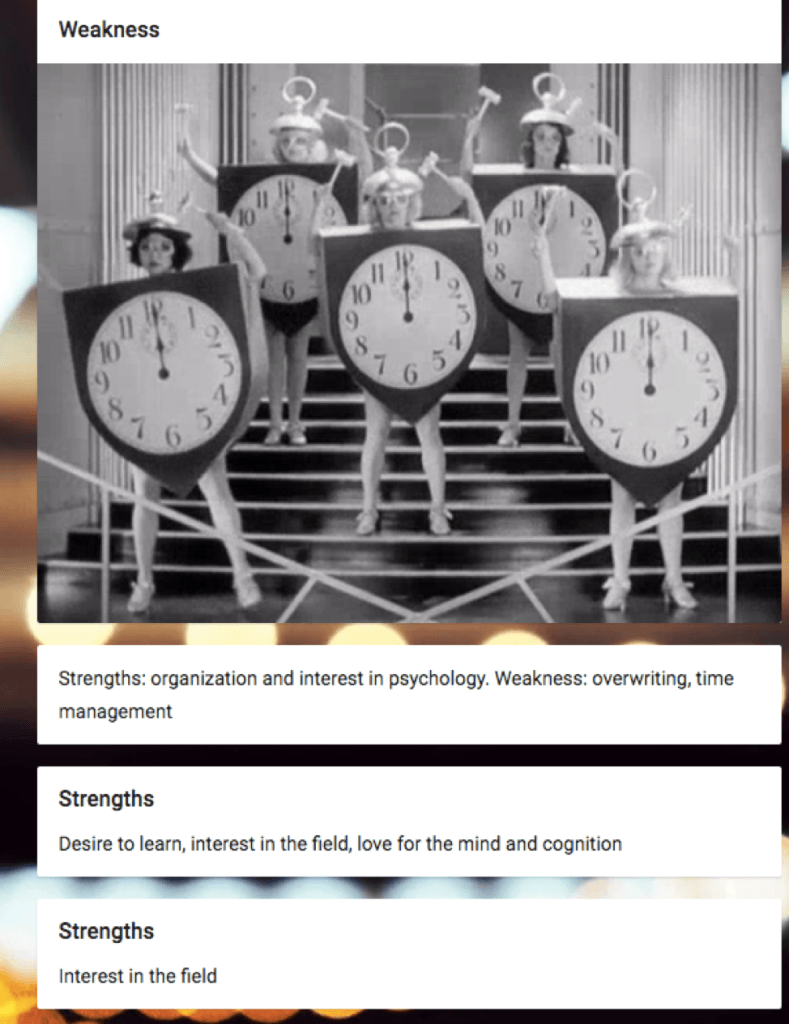
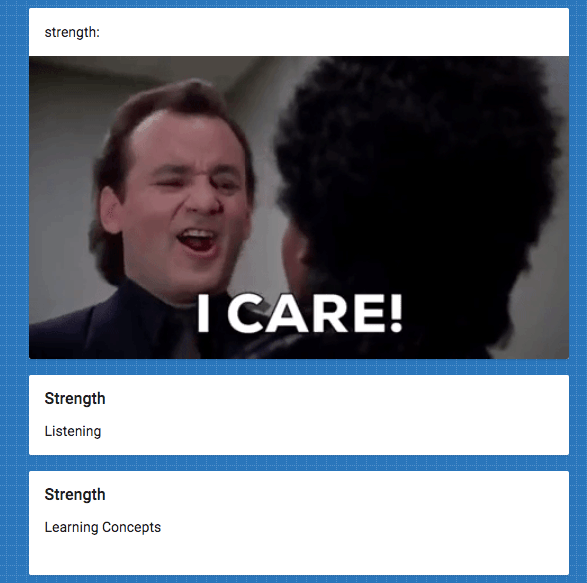
In previous semesters without Padlet, this prompt would elicit an average of three to four responses. With using Padlet, the question now averaged 30 responses in a class of 20 students.
In previous courses, some students have expressed learning better through visual means. By accommodating students that learn better visually, the Zoom video tutorial provided these students with a useful resource for learning.
The Padlet project was valuable in that the app provided students an opportunity to not only be exposed to the thoughts and feelings of their classmates, but to be able to express their thoughts and feelings to their peers as well. These opportunities do not always readily present themselves in more traditional communication formats.
Project Reflections and Next Steps
One thing that did not work for the Zoom video tutorial project was being able to view how many times students either accessed or watched the video. This was due to the way in which I uploaded the video file on to Moodle. Next time, I will create a Panopto activity in the course Moodle page, which will then direct students to the video tutorial. That way, I can generate activity reports on how many students have watched the video.
Another thing I would change is how I assess the effectiveness of the video tutorial. At the beginning of the semester, prior to loading the video to Moodle, I can assess students on their skills and knowledge on APA formatting. Then, I can load the video to Moodle and re-assess the students on their APA formatting knowledge and skills a few weeks later. By incorporating the activity reports of the video tutorial into these analyses, I can assess how much of an impact watching the video tutorial had on their skills and performance.
A potential future modification of this project is to incorporate the video tutorial into an EdPuzzle. Not only does this provide an opportunity for a formative assessment of their skills, but also makes the tutorial interactive. A second potential modification is to break up the tutorial into segments. With a total running time of nearly 30 minutes, it might benefit students to view this tutorial over several videos that are shorter in duration.
For the Padlet project, one thing that did work was the number of responses received from students. Despite the frequency of responses, one thing that did not work was how much students elaborated with their responses. In the future, I will encourage students to elaborate on their responses. One way to modify this project in the future is to change the layout of the Padlet to perhaps a canvas or grid, depending on the nature and context of the question.
One big lesson that I learned from these projects is that encouraging students goes a long way to get them to buy into and utilize the technologies. For the tutorial video, I made somewhat of a fuss about it by making a point to let students know about this particular resource compared to the numerous other resources they have access to on the course Moodle page. By acknowledging this video and drawing their attention to it, I am not sure how many students would have used the video or perceive any value in the video. The same logic of getting students to buy into the technology applied to Padlet. Prior to using Padlet in course, most (if not all) students had no experience with this technology. Encouraging students to work through the (relatively quick) learning pains of using the app paid off as the class quickly got the hang of the app. Within minutes, students were responding using GIFs, emojis, and pictures.
Dr. Lora Walter – Nursing
Project Overview
Introduction forums are a common practice in online courses. Students present themselves personally and professionally through the written word. The written word can lack intonation, emotion, and personality which are key elements in a live introduction. I explored the multiple methods of audio/video presentations and tried VoiceThread a few times. Too often the VoiceThread technology was challenging for the student and became the focus of the task. I sought to find a simple method that required minimal technology experience but provided a video that could be used in lieu of a written introduction in the course. Since most students are comfortable using their smart devices for videotaping, FaceTime, and other video-related applications, it seemed feasible to seek a tool that could be used from their phone or another device.
Flipgrid is a video discussion platform that is simple to use and can be accessed through any smartphone, tablet, or computer. It gives students a voice and educators a means of creating a communicative learning environment. Students are able to respond to the videos posted by the instructor or peers by reacting, responding, and sharing their own videos. Flipgrid has many features which students are familiar with thus leveraging the elements of social media to engage students in the classroom and promote communication.
This video method of introduction should be more effective in humanizing the online class. Students can connect on a more personal level which is usually lacking in the written introduction. This personal introduction could enhance their interactions in weekly activities like discussion forums and encourage richer dialogue.
For my project, I incorporated Flipgrid into online RN-Bachelor of Science in Nursing (RN-BSN) and Master of Science in Nursing (MSN) courses I taught in the Fall 2018 and Spring 2019 semesters. I also used the Flipgrid introduction approach with first-year undergraduate Pathways to Nursing (PTN) students in Summer 2018 prior to the students meeting in person at the orientation.
Project Planning
The initial step in planning this process was a literature search to determine current best practices. Also, using Bloom’s Digital Integration Model, I determined the focus should be at the highest level—creating. The written introductions are at a lower order of thinking and creating and viewing introductory videos should be a more effective modality through utilizing higher level thinking. After this initial investigation, I sought to find a technology tool that would be most effective.
With support from the Instructional Technology team, I narrowed my search and focused on technology applications which were simple, functional, and compatible with Moodle. Flipgrid seemed to be the best choice. I embraced the tool and sought to master it prior to implementation. Microsoft recently purchased Flipgrid and improved the already successful tool. Flipgrid has excellent learning materials for both students and teachers. I took advantage of all that was offered and became certified as a Flipgrid instructor. Through this process I mastered the use of the tool and planned to incorporate it into the classes I taught last fall.



Retrieved from https://flipgrid.com/
Project Implementation
The implementation process was bifurcated. I produced a Flipgrid introductory forum for two online courses in the RN-BSN and MSN programs. Then I created a Flipgrid forum for the incoming first-year on ground students.
First, I created an introductory Flipgrid forum for my online students. Students in the RN-BSN and MSN courses had experience with written introductory forums. I prompted them to introduce themselves both personally and professionally and discuss their intended outcomes for the class. The students created videos that were personable and demonstrated their true personality. Their peers were able to add comments or videos in response to the introduction. As the instructor, I found the introduction more personal and emotional. It provided the opportunity to meet them virtually, respond, and appreciate their intended outcomes for the class.
Secondly, I sent a Flipgrid link to all incoming first-year students to create a video and meet each other virtually. The first-year nursing student orientation is limited to two hours and the personal introduction of each of the 32 students would have left little time for the presentation of pertinent information. PTN is an undergraduate program where nursing students spend their first year on the Chatham Shadyside campus. The second and third years they attend UPMC Shadyside School of Nursing (SSON) and complete their degree with the online RN-BSN program their senior year. Success in nursing school requires collaboration with peers through mentoring and study groups. It is imperative that students know who their peers are and develop friendships with an academic partnership as soon as possible.
Several weeks prior to starting at Chatham, the PTN students were sent a link and asked to create an introductory Flipgrid video. They were prompted to introduce themselves personally and share why they want to become a nurse. Most students embraced this opportunity and videos were created all over the United States. One was created in Finland where the student was visiting prior to starting college.
Example of a PTN Flipgrid introduction provided with permission from the student.

https://flipgrid.com/s/b2fdabb806b2
Project Assessment
Summative assessments were conducted using Qualtrics surveys a few months after students engaged in the Flipgrid introductory activity. Both the online RN-BSN and MSN students and the undergraduate PTN students found value in the activity. As indicated formally through the Qualtrics survey and personal discussion, the project provided the students a means to actively engage in introductory forums that were personal and enhanced communication.
RN-BSN and MSN Application
For the online RN-BSN and MSN courses, students were surveyed and asked to compare their Flipgrid introduction experience with the usual introductory forum using the written word. Qualtrics software was used to survey the students who participated in the Flipgrid introductions. Since some of the students might not be technologically savvy, they were asked if Flipgrid was easy to use and helped personalize the course.
The students found the videos more personal than the written introductions. They indicated the technology tool was simple to use and found it more impactful than the written introductions. They were able to know their peers on a more personal level, which many found an asset to class activities like discussion forums.
Question: Did you find Flipgrid easy to use?

Question: Do you feel a video introduction personalizes this course?
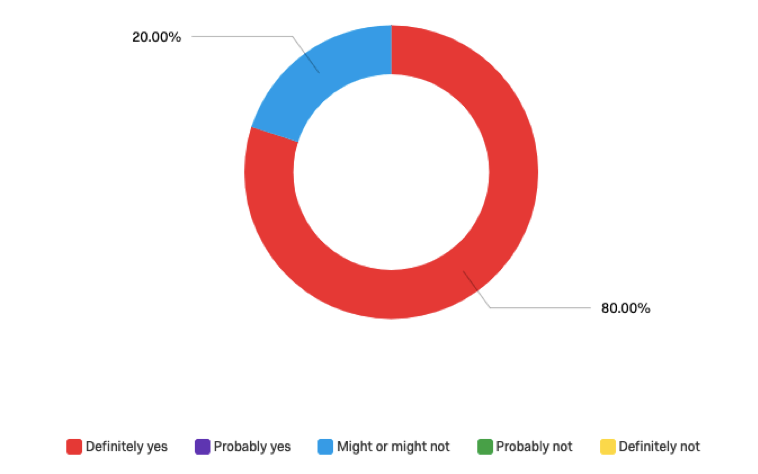
Pathways to Nursing (PTN) Application
Flipgrid was employed with the first-year nursing students who had never met before. They created the videos prior to the live orientation the first week on campus. The students posted videos that truly demonstrated their personality. They were prompted to discuss why they chose nursing as a career and the responses were passionate and varied. When the students entered the orientation room, they recognized each other and remembered key elements of each other’s videos. In many cases, it was as if they already knew each other. This made the orientation flow more easily and the presented information was better received.
Students were surveyed a few months after the Flipgrid introductory activity using Qualtrics. Two questions addressed the ease of use and the effect on increasing their comfort in starting college. The students found Flipgrid easy to use and indicated it helped reduce the anxiety with starting their college career. They found things in common with their peers and several of the students continued friendships and academic relationships. These relationships were the start of activities like study partners and groups and peer mentoring.
Question: Did you find Flipgrid easy to use?
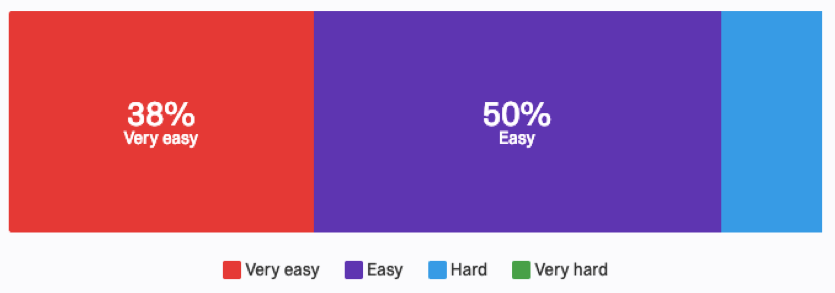
Question: Did Flipgrid videos increase your comfort level for starting your college career?
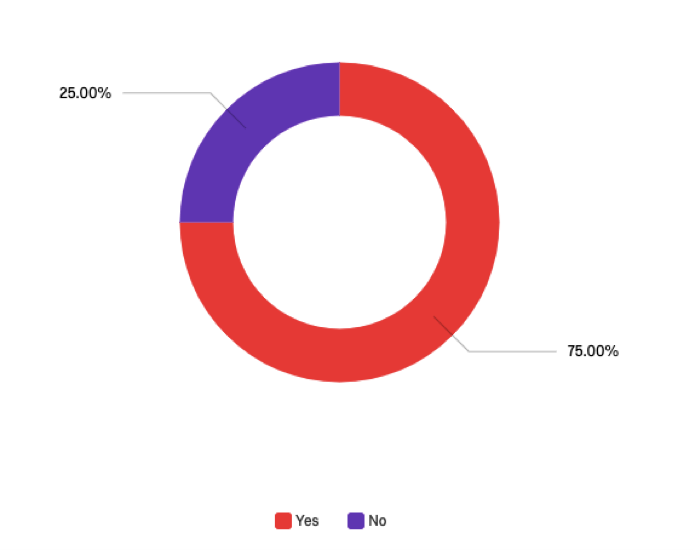
Project Reflections and Next Steps
I plan to continue using Flipgrid in my course introductory forums. The personal introductions promoted a sense of community amongst online students who never meet in person and on ground students prior to meeting in person. Students found the tool easy to use and effective in personalizing peer interactions.
Moving forward I want to use Flipgrid as a type of formative assessment. Formative assessment is a common application for Flipgrid that has been used by teachers in various levels of education. This pedagogical approach allows educators to assess student learning in a unique and personal manner. Additionally, the tool is commonly used to gauge how students are feeling about the class and where they want to progress. They can connect class content with their own experiences. Since words are often misconstrued, video assessment provides an opportunity to provide feedback that is genuine and presented with the positive attributes of the spoken word. There are many uses for Flipgrid in the assessment process, both formative and summative. Educators are privy to a website, webinars, and personal support that afford them the opportunity to use Flipgrid in their classrooms in a multitude of ways. Ultimately, I hope to inspire other educators to use Flipgrid or another form of video technology to create a sense of personalization and community in their courses.
Fostering Student Engagement
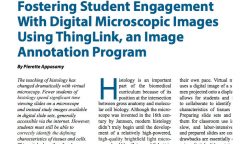
Dr. Pierette Appasamy’s article Fostering Student Engagement With Digital Microscopic Images Using ThingLink, an Image Annotation Program is published in The Journal of College Science Teaching.
This publication is a result of her tech fellows work with ThingLink and other technologies.
Congratulations, Pierette!
Video Feedback
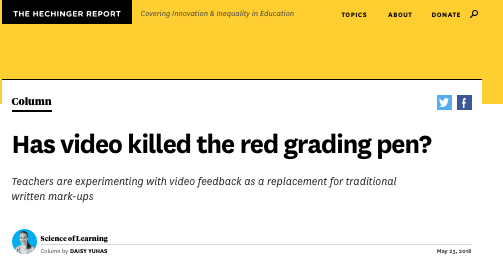
The Hechinger Report published a column on feedback called Has video killed the red grading pen? Both Monica Riordan and Meigan Robb were interviewed and quoted in the article. Faculty feedback is a topic that both faculty addressed in their tech fellow projects.
We are proud of their work and thrilled we get to work with such great faculty!
Dr. Carrie Helms Tippen – English
Project Overview
The main goal of the project is to introduce students to digital humanities, a new and growing subfield of literary and interdisciplinary studies. The technology and the skills are transferable to other fields because the assignment is project based, independently driven, and gives students experience researching, collecting, publishing, and being aware of audience. The project meets my pedagogical and philosophical goals of the public intellectual by making the work of the university freely available to real audiences.
- At the beginning of the semester, students were assigned a primary text from the syllabus. They were allowed to work independently or in small groups.
- By the end of the semester, the student(s) added a minimum of 5 items to a collection hosted on Omeka (an online archiving tool) related to their assigned text. At least one item should be an original document demonstrating their own interpretation of the text using digital humanities methods: a video, slide show, map, graphic, database, website, transcription, etc. Other items could be links to other DH projects, PDFs, images, scholarly archives/research, any existing scholarship or archives that interpret or give context to the text.
- When we read their text in class, the student(s) assigned to it offered a presentation and lead discussion of the historical context surrounding that text. This presentation was meant to be informative, based on academic/scholarly research, and general internet searches (focusing on sources associated with libraries, universities, archives, etc.). This was a step in the process of creating materials for the Omeka archive. The class gave feedback about what is included in the presentation and what further research could be added.
https://prezi.com/view/46ZkbkMacxTrvrUe7YLH/
Planning Process
The primary challenge in planning this project was figuring out how to add an introduction to digital humanities and instruction in tech tools to an already full syllabus of reading and discussion. Every primary text I eliminated from the reading schedule also eliminated an option for students to research. I was also aware that in order for students to have the most time to complete their projects, they would need to make a lot of decisions about this project at the very beginning of the semester with very little prior knowledge or experience. I would have to get them from zero to independent in the first four weeks of class. So I planned a series of readings and “Digital Humanities Project of the Day” features to get them maximum exposure.
I also had to plan in a lot of check-points to ensure that students were working steadily and felt continuously supported in this foreign task. I asked them to think of me as an unofficial group member and project consultant. I met with each group independently to discuss their ideas, write a proposal, make recommendations for tools, and provide sample projects.
I used the SAMR model for planning. I did not want this project to be a “substitution,” like putting a paper online or using Omeka to make essentially an annotated bibliography. Instead, I really wanted students to use tech tools to create something they could not summarize in a five-paragraph essay, or to discover something about the text that was not obvious from traditional close reading practices. My goal was “redefinition:” a new way of reading or presenting the text that cannot be accomplished without tech tools.
Implementation
STEPS FOR STUDENTS (working individually or in groups)
- Choose a primary text from the syllabus to be the focus of the project. Read ASAP and begin preliminary research right away.
- Write a project proposal.
- Describe your group’s contribution to the Course Archive (excluding the new item that you will create). What is your primary text? What have you found so far that will be appropriate for our course archive? What kinds of items or objects are out there? Have other scholars already done DH-type projects with your text?
- Describe the new item that your group will create for the archive. What do you hope this finished product will be? What technologies will you be using to create the project? What data will you collect from the text? Can that data be overlaid with existing data?
- Why is this the project you want to create? What conclusions do you think you can draw from the data you will collect? What does this project add to the scholarly conversation about your text? Clearly articulate the goals and purposes of your project.
- Provide a timeline for your project with due dates for specific tasks. Assign roles to group members.
- Attach examples of the materials you intend to produce. These could be very rough draft versions, outlines, or storyboards of the materials you will produce OR materials that could serve as a model for yours.
- Describe what support you may need from the instructor (ideas and advice, connect with resources, learn technology, etc).
- Meet with instructor to discuss proposal.
- Keep records of process in a Work Log. Record all activities associated with this project: reading, researching, thinking, planning, outlining, writing, revising, note-taking, drafting, working with tech, learning new tools. Note time spent. Reflect often on progress and learning.
- In class presentation and discussion leading when your text is assigned on the syllabus.
- FINAL PRODUCT
- 5 items in the class archive on Omeka: at least one new item plus links to archives, scholarly articles, images, etc.
- Present findings to class in the final exam period.
CONTINGENCIES:
- I was afraid that students did not have enough information or familiarity with DH to come up with a new project on their own; the parameters might be too open and paralyzing.
- DHPOTD: Digital Humanities Project of the Day. I made links available and talked through the projects with students as a class to show many options.
- I created a set of pre-approved projects to choose from that could be applied to most any text (maps, timelines, wordclouds,etc).
- I should have had more in-class status updates and project sharing so that students were aware of ideas in other groups.
- My meetings with students around their proposals showed that they needed a lot of tech support or direction.
- I set up special office hours just for this class.
- I brought in a senior student with DH experience as a contact person.
- Students proposed projects that were far more ambitious than could be completed in one semester without additional support.
- I talked them through priority setting and gave permission to modify or limit the scope of their projects.
Assessment
I informally assessed students’ familiarity with Digital Humanities at the beginning of the course. As expected, students had very little exposure to DH as a scholarly activity, though they had much experience with tech tools and writing in online spaces. After reading an introduction to DH, they rated their understanding at about 2 on a scale of 1-5. After discussing that article and looking at many examples of projects, the class average moved to 4.
At the end of the semester, I administered a survey and collected 17 responses from a class of 23 students.
- Define Digital Humanities.
- All 17 answers were acceptable definitions. They centered on using digital tools to analyze written texts. Most responses emphasized accessibility: both the texts and the discoveries made from the projects were meant to be accessed in digital spaces by ordinary citizens. They also emphasized creativity in that the researcher was inventing methods of research or applying tools in innovative ways to create new knowledge.
- On a scale of 1-5, rank your feeling of anxiety when you first learned of this project. (1 = low anxiety, 5 = high anxiety)
- The average was 4. 2.
- Only one student responded with a low anxiety.
- On a scale of 1-5, rank your feeling of excitement when you first learned of this project. (1 = low excitement, 5 = high excitement)
- The average was 3.1.
- No students responded with the highest level of excitement, but only 2 responded with the lowest level of excitement.
- Now that you have finished the project, on a scale of 1-5, rank your feeling of satisfaction in the product you made (1 = low satisfaction, 5 = high satisfaction)
- The average was 3.5
- No students responded with the lowest level of satisfaction. Only one responded with the highest level of satisfaction.
- Did you work on this project alone or in a small group?
- 8 respondents worked alone.
- 9 respondents worked in groups.
- The average satisfaction for students working alone was the same as for students working in groups.
- Estimate how many total hours you think you will individually spend on this project by the time it is complete.
- 4 students chose the maximum (more than 25 hours)
- 4 students chose 15-25 hours
- 8 students chose 5-15 hours
- What (if anything) do you think you learned from this project that is applicable to other classes or scholarly work? Could you repeat any factor of this assignment in another class or in your future work?
- 4 students did not respond to this question
- The other 13 were generally positive and noted research skills as useful in other classes.
- “It’s important to force tech to catch up to the humanities. I would like to do something like this in other English classes.”
- “I can tell you it’s applicable, but I can’t word how”
- “It forced me to thoroughly utilize our library databases to find what I was looking for, and made me familiar with some that I hadn’t previously used, but of which I am now familiar enough with to know when to search through that database according to the content I’m looking for.”
- If you were assigned a project like this again, what would you do differently as an individual or group member?
- Students may have misunderstood this question as asking if they would change their group formation. 7 responses were about working individually or in a group (ex. “No I would still work in a group” was a typical but inappropriate response.)
- Recommendations from the other 10:
- Set checkpoints for amount of work
- Define search parameters earlier in the project
- Choose a different final project, perhaps more complex (“instead of just a map,” “I might try a more ambitious project, or have a partner.”)
- Choose the tool first then the text.
- Choose a text with more personal interest
- If you were the instructor giving this assignment, what might you change, add, or eliminate next year?
- More checkpoints during the semester (updates, meetings with instructor, in-class work sessions)
- More focus on the project, fewer assignments outside of project
- OR make it a short-term project
- Show more examples
Reflections and Next Steps
As I suspected, students were brand new to the idea of Digital Humanities, and even at the end of the semester, one student in particular responded, “it’s all too new to me to find a good answer” to the reflection questions. I succeeded in communicating to students the potential for creativity and the many possibilities for DH project, but that openness did not produce the best results for most students. A few really standout projects showed deep engagement with the methods of DH and the goals of the field. For example: Ben’s Excel spreadsheet of uses of the word “evil,” or Isabella and Katy’s Google Map of Samson Occom’s Life. But on the whole, as I suspected, students did not really have enough prior knowledge to be creative or the skills to meet their ambitions.
I think the next time I teach this class, I will keep the DH focus, but I will make the final a shorter-term project. It is an introductory survey class and the first introduction to an entire field of study with a class of mostly non-majors, so the assignment should be more supported and introductory. Instead of asking students to choose their projects in the first week of class, I will work with them through a few practice projects (maps of placenames, timelines of events, wordcloud analysis) as a whole class, demonstrating the decision-making processes and the technology in class, before putting them into groups to execute their own. I met with several students in the last week of classes who had made no progress on their projects since our initial meeting about the proposal in week 3, so even though DH projects are by nature time-consuming, they do not have to take 12 weeks to complete.
Overall, I think the project met my goals for introducing DH in the same way that tossing a person in the deep end of a pool “introduces” them to swimming. The immersive experience led to some really creative projects for a few upper-level students, but most students responded with safe projects and pedestrian ideas. I think the project can be revised so that the creative students can still maximize their creativity while providing enough support that more students can feel comfortable improvising and reach for creativity.
Dr. David Rossbach – Political Science
Project Overview
Conflict. Mission: Zhobia is a web-based simulation that places the student in the position of a non-governmental organization (NGO) worker tasked with developing a plan to reconstruct the justice system in the fictional conflict-ridden country of Zhobia. Students must perform background research into My project involved incorporating the Mission: Zhobia simulation-game into POL 302 Ethnic the conflict, interview a variety of political and social stakeholders, and ultimately provide recommendations regarding the location of the court, training structure for legal staff, and the underlying legal framework for the new justice system. Upon submitting this report, the students are then told what the after-effects of their plan were.
Planning Process
As Mission: Zhobia simulation is a free, pre-packaged website there was little planning involved in its implementation from a design stand-point. The simulation came at the end of the introductory unit of the course where we focus on different institutional design issues in managing ethnic conflict situations. The lectures leading up to the simulation consistently stress the trade-offs one must consider in designing post-conflict political instructions and the notion that no one institutional structure alone will solve all the problems.
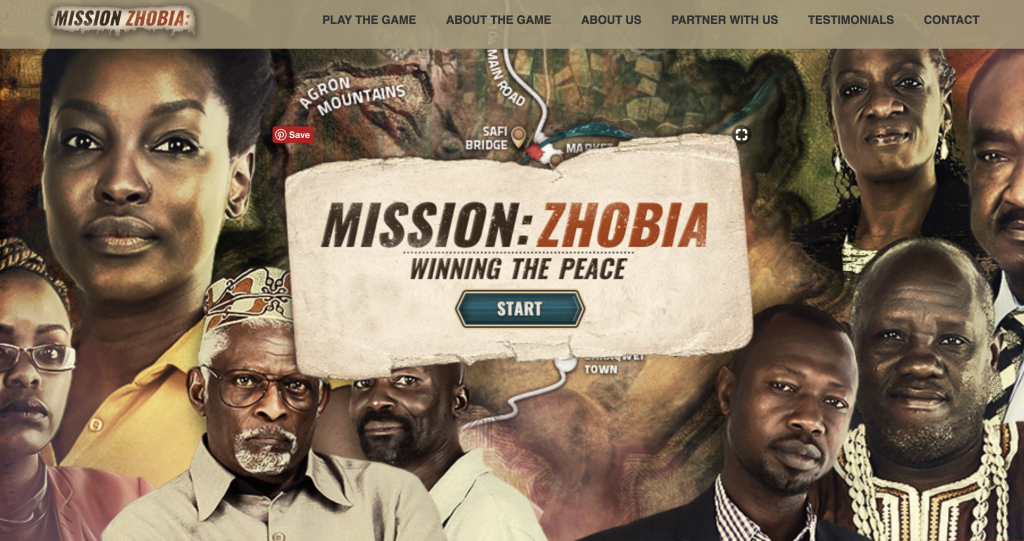
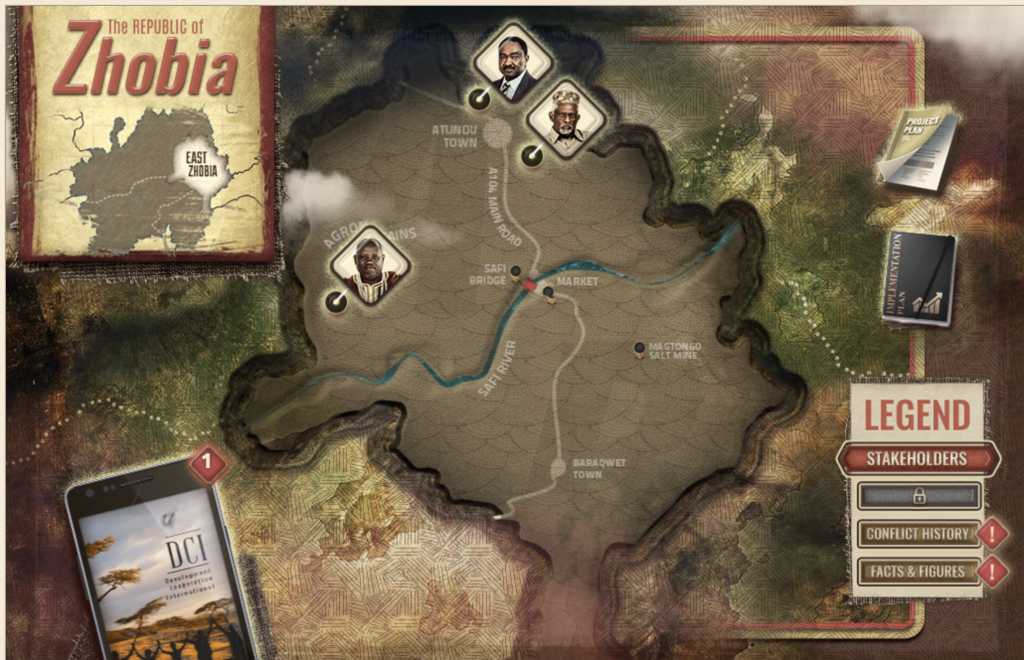
Implementation
I scheduled the simulation for the week following class readings and discussion regarding political institutions in conflict situations. We devoted the first one-hour and fifteen-minute class meeting of the week to students playing the simulation, and the second class meeting was a discussion and debriefing session. Students were asked to bring their own laptops to class that day and everyone was able to do so. The only logistical concern was whether students would be able to complete the exercise within the hour and fifteen minute time period. All but two students were able to and those students completed their exercise immediately after class.
Assessment
I assessed the exercise with a combination of formal and informal tools. Formally, the students were asked to complete a questionnaire asking them to share specific decisions they made along the way and to reflect on their experience. Informally, we devoted the class session following the simulation to a discussion of the students’ evaluations and observations.
For the reflective portion of the questionnaire, the students were asked 1) what they felt were the three most important items critical to success in the simulation, 2) what they would do differently along their own path of completion, and 3) what they learned through the process that they had not realized beforehand.
In response to question 1, student consistently stated that the most important consideration was gaining the trust of regional stakeholders was the most important element to consider. They observed that more decision options were presented to the player as they engaged with local leaders. The second most cited consideration was adequate background preparation. A number of students seemed to jump quickly to engaging the local leaders without doing their homework on the conflict in Zhobia. When leaders would ask them questions pertaining to the conflict, if the student answered incorrectly they would lose trust, limiting their options down the line.
Question 2 yielded results consistent with the prior observation. Students said they would have spent more time on the background materials and preparing for the stakeholder interviews. They also indicated that they would have avoided decisions early on that restricted their options later in the simulation.
Finally, in response to question 3 the key lesson the majority of students took away was the difficulty in finding solutions to the conflict that all sides would find acceptable. In our class discussion, numerous students indicated that they had chosen options they felt were sound and yet found that the situation descended back into violence after their report was submitted.
Reflections and Next Steps
I feel the simulation was a resounding success. I was concerned that the game setting would appear frivolous in the context of a course with such a grim topic. And yet watching the students reactions while they were participating indicated that they were actively engaged. The assessment results indicated that the primary lessons to be learned were in fact taken to heart by the students.
It would be possible to run this simulation outside of actual class time and devote the same time to post-simulation assessment activities. This is something I would consider next time. On the other hand, being available to address questions and potential technical glitches was also important. The time restriction within class may have rushed some students yet I found that 1 hour 15 minutes was adequate time for background research and questioning. Most students completed in the time as well.
In the final analysis, I found the Mission: Zhobia! simulation to be a very useful classroom exercise. The simulation showed them through experience what I could only stress in lecture: the importance of preparation and openness of dialogue when engaging in peace-building measures. Numerous students indicated that they went back and played the simulation multiple times to try and achieve a perfect score. This is final evidence that they themselves found the simulation to be an engaging experience. I look forward to running this experiment again the next time I offer POL 302 Ethnic Conflict and comparing that student experience with this one.
Dr. Julie Slade – Nursing
Project Overview
For my project I used EdPuzzle in the NUR411 Geriatric Nursing class to give students a different perspective on loss, how difficult loss can be, and to help them experience some feelings their patients or patient’s families are experiencing. The essential idea is that, by incorporating EdPuzzle and changing how learning activities are presented, students will engage more in learning activities and increase their course learning. The provocative question is “Will presenting course activities in a different format result in increased student engagement and learning?” With this activity students should be able to display increased knowledge for the topics being covered.
Planning Process
When considering a project for Tech Fellows, I was in the midst of revising the NUR411 course and wanted to continue incorporating death and dying in the course. The course was becoming heavy in topics and there was a lot of reading then answering questions involved. I wanted to change that and give the students an activity that they could complete that did not involve reading articles or websites while being interesting and resulting in students learning about the topic. I had an idea for an activity to incorporate into the class and EdPuzzle was the best way to do this. EdPuzzle allowed me to present a scenario to students that they could immerse themselves into and experience the feelings that accompany a loss at the end-of-life. I could not find a video for this specific type of activity so I wrote a script and recorded a video myself allowing for the question/answer segments in the video to help guide the students through the activity.
While planning for this project I considered the type of activity to incorporate in the class, how long the activity should take, the potential outcomes of the activity, and any follow-up that might be needed from the activity.
This activity was not incorporated to meet any specific course or learning objectives. The activity was designed to help students engage in a class activity and gain knowledge from the activity.
Implementation
Once the video was made and the EdPuzzle was created, incorporating the questions as appropriate, directions were written and all was inserted into the course shell. Several colleagues were asked to trial the EdPuzzle, using the directions as written in the course, to ensure quality of the EdPuzzle as well as the activity students were required to complete. Once all was in place the activity was open for the students as appropriate in the class.
A Plan B was not in place as all trials indicated that the EdPuzzle would work in the class. If the technology did not work I was planning to offer students journal articles or other readings to complete on the topic. If, after the students completed the activity, the students did not like the activity another method to approach this course material would need to be decided on.
Assessment
After students completed the EdPuzzle activity in the course they completed the weekly discussion forum. One of the questions in the discussion forum focused on the topic of the activity: “Each of you were required to complete the Loss Exercise using EDpuzzle. I know this was a difficult exercise to complete and if you need/want to debrief contact me so we can talk. What are your thoughts after completing this exercise? How does this exercise change your thoughts about elders and the challenges they face? Is there anything else you’d like to share?” The responses were varied. Some students shared how they had never considered loss before or how they would feel facing this type of loss. Others shared that this activity gave them a fresh perspective that they can use to empathize with their patients, the patient’s family, or their own family. Overall responses were positive and displayed engagement and knowledge gain.
To assess the EdPuzzle itself the following questions were asked: “Feedback questions – your responses would be appreciated: What are your thoughts about EDpuzzle (not the specific focus on end-of-life and the dying process but the mode of education)? Is this an effective learning tool? Would you recommend this tool be used more frequently in the RN-BSN Program?” The vast majority of the students responded to the feedback questions and stated that they enjoyed the activity. They felt that it was an effective learning technique and a refreshing departure from the typical pattern of reading journal articles or websites and responding to essay questions. Students enjoyed the immersion into the activity and the personal feelings that came from completing this type of activity. Some students did struggle with the directions resulting in directions being reexamined and edited for future classes.
Overall I am extremely pleased with how this activity turned out. Students engaged in the activity and displayed new levels of knowledge and learning. Feedback was positive and encouraging for further technology uses. Some students requested further technology incorporation into the courses to move away from typical course set up.
Reflections and Next Steps
Overall everything worked. The activity has now run twice and both trials have been successful. I anticipate continuing to use the activity, as is, in the course for the foreseeable future.
I learned that the majority of students are eager for a different type of learning activity and they will engage in one if offered. This met my goal of increasing engagement and having students obtain a higher level of knowledge. My next steps are to look at other topics in the course and determine if there is a type of technology that can be incorporated to increase engagement and student interest there, as well.
Dr. Sharon Novalis – Occupational Therapy
Project Overview
This project utilizes the Feedback Survey feature in Moodle for students to assess their levels of confidence in various aspects of the Evidence-Based Practice/Process (EBP) (including objectives contained within the Accreditation Council for Occupational Therapy Education Standards). An accompanying One Sheet assignment challenges students to address the results of the self-assessment. Through the use of a pre-/post-test design, students level of confidence is assessed before and after completion of the One Sheet assignment.
Planning Process
I selected this project because of the timeframe in which the Tech Fellows presentations were scheduled to occur. Though I have other courses that would also benefit from additional use of instructional technology methods, a project that was focused on the EBP courses was more feasible, most notably as it related to implementation.
Because a large portion of the EBP series process involves student group projects, assessment of individual learning, particularly in the application of EBP processes, is challenging. Although the group processes address clinically relevant content that requires an exploration of available evidence, the skills that are needed to complete the EBP process are varied in level of complexity. Identifying individual strengths within the group at times results in student performance of tasks that are aligned with areas of strength. This may facilitate a more successful group process/product, but this approach is not optimal for individual skill building/individual learning. This project utilizes each of the course objectives from EBP I and applicable objectives from EBP II which are based upon the ACOTE Standards. For the purposes of this project, these objectives serve as the primary items for each student to individually self-assess their level of confidence. Some of the objectives are knowledge-based, while other objectives require active demonstration of skill (for example, the ability to articulate an EBP concept).
Because the Master of Occupational Therapy program curriculum sequence is based upon the concepts of skill acquisition, development, and active learning, this project is also the foundational underpinning, both for the assessment components and for the process of creating the One Sheet.
Implementation
This project was developed and implemented as follows:
- Consultation with Lauren Panton regarding project concept/idea occurred.
- Confirmation of concept from Lauren Panton was received during this consultation.
- An individual exploration of the Feedback feature in Moodle was undertaken to determine applicability to this project.
- OTH612/EBP I, applicable OTH628/EBP II, and ACOTE Standards were collected.
- Each objective was formulated into the question beginning with “How confident are you in …….” (Actual examples will be provided).
- A total of 26 questions were loaded into the Feedback feature in my Sandbox.
- Consultation with Becky Borello occurred in order to trial the administration of the Feedback survey and to determine the reporting features associated with Feedback.
- A workaround was identified in order to achieve numerical data in Excel for purposes of analysis (utilization of the Find and Replace function).
- Students completed the Feedback survey, having been instructed to complete this survey outside of class, individually, and to base their responses in consideration of their own reflections and based upon any feedback they’ve received from any professor since their admission into the MOT program.
- All data was converted to a numerical score in an Excel file.
- Student averages were calculated.
- Individual scores were examined for the associated content area.
- Once all students had completed the Feedback survey, the students were randomly paired with a peer for the One Sheet assignment.
- Students received instruction on the One Sheet assignment while in class.
- A rubric was provided (Actual example will be provided) to facilitate the content level of the One Sheet.
- Students were asked to identify their lowest scored (based upon their self-assessment in the Feedback survey) items/content areas.
- Students received their responses via individualized email from the instructor.
- Students prepared the One Sheet with their peer which contained two items/content areas.
- Students had one week to create and submit their One Sheet.
- Submission deadline was set for an hour prior to the scheduled class.
- Students completed the Feedback post-survey while in class.
- All data was converted to a numerical score in an Excel file.
- Pre/post data was analyzed for the presence of change in scores and for changes in the individual average score (pre to post).
Assessment
This project contained formal assessment. Because of the pre and post design and through utilization of a Likert scale to assess self-confidence, scores could be analyzed by individual item or by content area and could further be assessed in terms of change over time.
This project provides both formative and summative assessments specifically related to students’ level of confidence in specific evidence-based practice/process skills. Students are encouraged to reflect upon their knowledge-base and EBP skills and are also able to compare their change in levels of confidence.
This project also gives the instructor valuable information that may impact the information that is presented within the first course within the EBP series, how learning is assessed and what additional assignments might be used to facilitate active, self-directed learning.
Students also benefited from this project, in that 35 out of 39 students demonstrated an overall increase in their level of confidence upon completion of the pre/post Feedback Survey and the One Sheet assignment.
Reflections and Next Steps
The concept of using a survey to assess students’ level of confidence worked well. The ability to compare pre/post scores by individual item, by content area, and overall average contributes to the usefulness of this project. Utilization of the One Sheet, as well as the pairing of students, also contributed to the usefulness of this project.
Moving forward, it would likely be beneficial to utilize this survey at the very beginning of EBP I to get a baseline on students’ level of confidence. This might also result in changing the emphasis on various content areas/objectives.
Pairing the students on an assignment that requires selection and discussion of content areas, creativity, examination of additional resources, and development of individual, measurable goals all encourage self-reflection, self-directed learning, and accountability.
I would likely utilize a different avenue within Moodle to administer the survey (such as Questionnaire) because of the limitations of the Feedback option on students’ ability to retrieve their submitted ratings. Otherwise, I believe that the overall project was a success and would definitely utilize the various components of this project again.
The additional points I’ve learned…..again that there are many ways to utilize technology to enhance teaching/learning opportunities. Personally, I believe that my own growth (and level of confidence!) related to the use of technology has been noteworthy. The anxiety that initially presented itself in contemplating the use of the various forms of technology has been remediated with a growing knowledge base, an expanding skill set, and a knowing that persistence and patience (primarily with myself) will lead to great opportunities as an instructor and as a life-long learner.
Several additional notes: I want to express my thanks to Chatham University for providing such a wonderfully generous program. Without the time and the actual technology ‘equipment’ provided, it would be quite challenging to make the gains that I’ve experienced. The ability to interact with colleagues, my fellow Tech Fellows, and my Tech Fellow buddy regarding specific application of technology to the classroom has been very helpful as well.
Beyond that, a point that I have learned numerous times over since I joined the Chatham Community….that Lauren and Becky are amazing teachers, guides, facilitators, ….completely willing to problem-solve alongside, provide direction, provide numerous tips, strategies, presentations, all to facilitate successful use of technology for instructional design and implementation. Their calm, kind approach, combined with their sense of humor really have encouraged me to keep taking my next steps in exploring technology. This all has been a great triumph for me professionally, but has also been a wonderful personal achievement as well. My deep gratitude to Lauren and Becky.
Dr. Tyra Good – Education
Project Overview
My primary goal was to increase student learning and engagement by integrating innovative ways to communicate and disseminate information through exploring technology tie-ins to instruction, assessment, and presentations. I wanted my courses to provide an opportunity for students to explore culturally responsive educational practices and professional development learning experiences through social media platforms that are best for teachers to communicate with their future students, families, and the community.
Learning is no longer only defined by time and place. A wide variety of digital networks, platforms, and content resources are being created to personalize learning to ensure that the interests and values of the whole child are being met. I approach my work to transform teaching by equipping students to work in diverse learning ecosystems with children and their families. To date, I have used Sway, Twitter, video and audio equipment, and Reality Works Real Care Baby Simulator to increase student engagement through active learning and reflection.
Planning Process
During the Summer of 2017, the Technology Fellows summer professional development series provided exposure to instructional technologies and time to reflect on how we would redesign our courses with instructional supports and technology enhancements. We learned about a myriad of technology platforms, applications, and software to increase student learning and engagement. As I begin to explore and try out the new technologies through a trial run, I could not settle on just one technology tie-in to integrate into my courses. Therefore, I used a multifaceted interactive technological approach to incorporate into my courses.
Implementation
During Fall 2017, I taught a new course online, EDU 606/607: Child Development and Adolescent Learning Theory. This course focuses on child development in the context of social, cultural, and instructional settings and how these factors play into learning theory. Students apply knowledge of developmental stages to create authentic classroom learning environments that are healthy, respectful, supportive, challenging by utilizing culturally responsive instructional techniques. I used the interactive platform, Sway to make the information and text more engaging. The purpose of Sway is to convey concepts quickly, easily and clearly. Unlike PowerPoint, it is primarily for presenting ideas onscreen rather than to an audience. Sway allowed me to integrate text, articles, and video into one interactive Word document so students did not have to click on multiple documents or folders to access the weekly course content.
Below are examples of Sway documents that I created for class.
Sway Example: Module 4A-Middle Childhood
Sway Example: Module 4B-Middle Childhood
(Click on the pictures below to view them larger)
This Spring 2018, the two courses that I decided to focus on were EDU 105: Child Development Birth through Grade 4 and EDU 505 Issues of Poverty and Race in Education. I partnered with Saturday Light Brigade to provide the audio recording equipment for my students to record their learning experiences. SLB Radio Productions, Inc. (SLB) uses radio and audio to encourage, amplify, share and archive the ideas, stories, and feelings of children, youth and families. They provide an innovative method to promote increased creative expression, critical thinking, and technical curiosity.
EDU 105 is a required course for PreK-4 education undergraduate students; however, it is open to other undergraduate majors as well. This course focuses on child development in the context of social, cultural, and instructional settings and how these factors play into learning theory. Students apply knowledge of developmental stages to create authentic classroom learning environments that are healthy, respectful, supportive, challenging by utilizing culturally responsive instructional techniques. I integrated the Reality works Real Care Baby Simulator project to provide a simulation experience of how a real baby acts. The students had to care for the baby as if it were real over a 48 period. They had to change, rock, feed and burp the baby.
Below are pictures of our project (Click on the pictures below to view them larger).
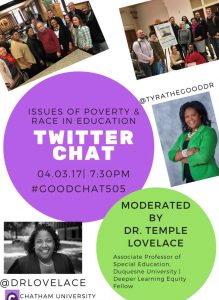
EDU 505 is a course taken by secondary education graduate students that focuses on the characteristics and effects of poverty and race in education through examining types of poverty and racial biases in schools, as well as the impact of poverty on cognitive and physical development.
I wanted to build upon the social media engagement that I incorporated into this course the previous semester. In this course, the students had to write weekly reflections after each class session on Twitter. We also had a course culminating Twitter Chat that will be held again this semester.
The students share strategies they learned during the semester to equip educators, parents and the community in ways to address issues of poverty and race in education. You can search #GOODChat505 on Twitter to see our class reflections.
Below are examples of our Twitter posts (Click on the pictures below to view them larger).
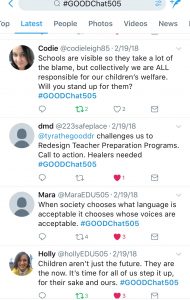 |
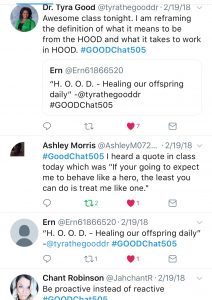 |
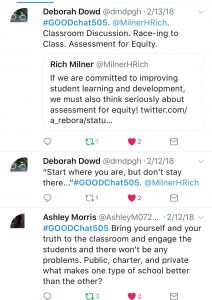 |
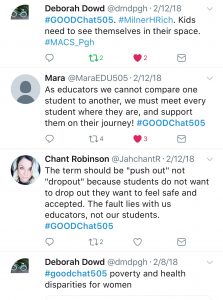 |
|---|
Assessment
EDU 606/607: Child and Adolescent Development and Learning Theories
The students completed an open-ended questionnaire at the end of the semester to gather feedback on using SWAY for their weekly class information and assignments. The questions focused on the effectiveness and ease of the interactive document and whether or not it increased their engagement in the online course. Most of the students thought the Sway format was simple to navigate, appreciated the flow of the assignments and graphics, and indicated that they would consider using the tool in their own classroom teaching.
Questionnaire:
Please describe your thoughts about using the interactive SWAY’s that contained the weekly module focused content.
• Was the tool effective?
• Was it easy/hard to follow?
• Did it increase your engagement in the course?
• Did you enjoy learning this way? (Using One interactive Word Document)
• Should any content had been added or deleted from the SWAY’s? If so, please explain.
• Would you consider using a SWAY document in your classes as a classroom teacher?
EDU 105: Child Development: Birth through Grade 4
While engaged in the baby simulation, the students had to document their experiences through pictures, journal entries, and Vlogs. I was able to monitor their progress through the Reality Works Real Care Baby Simulator software. The students had to discuss and present their experience in class according to the learning outcomes.
EDU 505: Issues of Poverty and Race in Education
The students are encouraged to tag the authors of our course readings and other educational leaders to share their learning or to ask questions either for clarification or rhetorical when doing their Twitter postings. Although some students were reluctant in the beginning of the course, many students ended up embracing this reflective learning exercise. They become excited and more engaged when their Tweets were “Liked” or re-twitted by educational scholars, legislatures, or community leaders. Our class Twitter Chat for this semester is scheduled for April 2nd.
Reflections and Next Steps
In reflecting on my use of interactive technology tools that I integrated into my three courses over this past academic year, I believe that there was greater student engagement because of the hands-on software and digital educational resources that were used. I appreciated learning ways to keep me engaged and excited in teaching the courses. The Sway document not only was a success with the students, but helped me to organize my course materials more efficiently. The simulation baby project provided a project-based learning experience that is essential to the education major students on their journey to developing competencies in teaching. The use of Twitter in my course allowed me to connect my love for the social media platform to increase student engagement while they shared their learning publicly. I was able to instantly gauge the students’ comfort and knowledge after each class session. Sharing their thoughts and reflections via Twitter allowed the students to become a part of an online community of learners focused on equity in education. I plan to continue using the Reality Works Real Care Baby Simulator, and expand the integration of Twitter and SWAY into my other courses.
Dr. MaryDee Fisher – Nursing
Project Overview
This project involved a redefinition of existing assignments in an online MSN course (Fall 2, 2017 – NUR/HCI 503), and in an online RN to BSN course the subsequent semester (Spring 1, 2018 NUR 412). Both assignments promote content learning. However, in order to better emulate the required teamwork required for clinical practice, both projects were redefined to afford learners the transformational opportunity related to a paired project within a collaborative learning space.
Planning Process
Both projects were redefined in order to afford learners a more realistic learning opportunity that mimics teamwork, specifically collaboration and communication elements, required for actual clinical practice.
The original MSN assignment was intended to create a draft of an automated Electronic Report of aggregate dashboard data that could be used to assess patient outcomes or staff compliance within the clinical arena. Learners in this course were from both the HealthCare Informatics and MSN graduate programs.
The original RN to BSN assignment was designed to have students use a Quality Improvement tool (FMEA) to analyze a clinical quality or safety issue related to the process of care delivery. All online learners in this course were or had been practicing as direct bedside caregivers.
In redesigning the project, some elements that underwent consideration include:
- How will this type of assignment (project) be completed in the actual clinical situation?
- How should/could the students be paired for the assignment? (self-select; random; specific assignment methodology)
- Is it a reasonable expectation for students to complete a paired project, given the lifestyles of online and various level learners?
- How might embracing of vs resistance to the assignment best occur with students?
- How to successfully cue for peer to peer communications?
- How can student choice be offered with a selection of collaborative learning space?
- In what format should the assignment be submitted (word doc vs link to actual space)?
- How will grading be accomplished? Individual vs. grouped?
- Peer Review needed for overall collegial (communications and collaboration) workings? How to incorporate feedback? What percentage of project grade?
Both assignments previously existed in the courses to meet specific learning outcomes.
In the MSN course related to Informatics Foundation and Health Care Technology, several learning objectives were enhanced by project implementation. They include:
- Analyze current and emerging technology utilized at point of care within a structured health setting and within a virtual community environment that supports safe practice.
- Discuss opportunities and strategies for extracting data from various systems to assess patient outcomes supporting a higher level of evidence-based care.
- Identify how technology and electronic data sources can be used to evaluate the effectiveness of clinical prevention interventions that affect individual and population-based health outcomes.
In the RN to BSN course related to Nursing Communication & Quality Improvement, specific learning objectives involving were targeted and enriched. They include:
- Demonstrate leadership and communication skills to effectively implement patient safety and quality improvement initiatives within the context of the interprofessional team.
- Participate in quality and patient safety initiatives, recognizing that these are complex system issues.
- Apply concepts of quality and safety using structure, process, and outcome measures to effectively implement and monitor patient safety initiatives.
- Demonstrate knowledge of interprofessional roles communication and effective teamwork.
Related to the personal goals of the author, a collaborative learning space had not been previously utilized and offering this project created a forced opportunity to learn about them.
The Substitution, Augmentation, Modification and Redefinition (SAMR) Model was used in planning both of the assignment revisions. Use the teaching-learning process to instill technology in the design process enhanced communication and collaboration skills.
Implementation
Steps to completion (ins & outs):
- Understand the value of collaborative learning spaces.
- Revise assignment guidelines and rubrics.
- Create peer review form.
- Secure resources from Hoonuit for collaborative learning space and place in courses with clear direction.
- Craft detailed directions for parings – who will do, by when and why will do.
- Reflect on and design a plan on when to offer repeated announcements and encouragement for project completion.
Plan B was to revert to individual assignment as per previously used in both courses.
Assessment
Both projects were summatively assessed in formal fashions.
The Peer Review form, required for project submission, solicited feedback on five quantitative behaviors for evaluation and qualitative questions specifically r/t teamwork effectiveness, teamwork behaviors and overall team functioning.
Value of the group assignment was overwhelmingly reinforced in both courses on these peer review forms. Interestingly, students did not always rate each other as 5/5 on the quantitative behaviors. Qualitative comments included those related to: working well together; the need for flexibility, as there is more than one way to get things done; technology being invaluable; need to utilize strengths of team members; learning about constructive criticism; communication is key, one needs to pay attention to the style used, and it is a the center of teamwork; need to establish a good rapport; importance of trust and respect; opportunity to practice leadership skills; enjoyed opportunity to work with someone form another profession; importance of clearly understanding other’s expectations.
Course Evaluations for the 503 course included qualitative comments such as: indicating learning to work in a group was one of the most important things learned in the course and enjoying working with other students on a project that at first seems overwhelming. 412 course evaluations are not at the time of this writing.
Anecdotally, the quality of assignment submissions was elevated overall in the MSN/HCI course; likely not as significantly in the BSN course for this challenging QI assignment.
Project Reflections and Next Steps
What worked and what didn’t work?
Worked – Clear guidelines expectations and rubric for assignments; communications related to the rationale for pairings; responding promptly and patiently to student inquiries; affording/encouraging students to hold one another accountable.
Worked, not so well – Not adjusting the peer review points for percentage moving from MSN to BSN course (math able to be calculated however).
Continue to strive towards more collaborative versus group learning where learners are mutually dependent on one another, yet held individually accountable. Promote increased group effort versus divide and conquer mentality; encourage an emphasis on process, in addition to the final product. With collaborative projects, the learners co-create knowledge and meaningful learning.
What would you change for next time?
In MSN course – leave as is if appropriate mix of HCI and MSN students.
In RN to BSN course – provide weekly reminders about the upcoming project and specifically direct to communicate one on one with their partner early in the course.
How would you modify the project?
Consider student submitting a link to the collaborative learning space instead of submitting in Word; afford the opportunity to self-select partner; tweak guidelines to further promote collaborative project outcomes.
What did you learn?
Technology can be slowly integrated into assignments to afford to learn by students and faculty alike; all techno changes do not have to be flashy; reinforced need to stay focused on learning outcomes and goals; and not all digital native students maybe be as technologically advanced and savvy as others.
Dr. Missy Criss – Physical Therapy
Project Overview
My primary goal was to find a way to enhance student observation skills and the clinical decision making that stems from those observations. My target courses were our Foundations of Movement Science series (2 courses – one in spring of 1st year and the second in the fall of the 2nd year of the program). Knowing that students in the first year of our program do not yet have extensive knowledge about specific pathology or disease processes, I created a set of sub-goals that were related using observation and using anatomy and physiology knowledge that they already possess:
- Improve student ability to identify and describe (oral or written) abnormal posture or movement pattern
- Improve student ability to hypothesize which body systems might be contributing to abnormal posture/movements
- Utilize evidence in decision-making
Planning Process
During our summer workshop, I worked with Lauren to look at various apps that would allow video analysis. I was looking in particular for an app that allowed slow-motion playback of recorded video and annotation of the video (voice recording over the video, drawing or highlighting portions of the video etc.). This was to enable students to watch movement at slower than normal speeds, with the hope that with practice throughout our program, they could start to see movement abnormalities in real time. I also wanted them to be familiar with an app that they might continue to use while treating patients.
Additionally, I was looking for ways to collect evidence in one central location so students could create a repository of evidence-based information that can be accessed later. My goal was to find something that allowed access after graduation, so I felt that Moodle was not the best option for this information.
After looking at several apps during our summer workshop, I decided to try Hudl Technique, which is an app for video analysis that is free. I particularly liked the ability to play 2 videos side by side (to compare movement at one time to movement at another time), the variable speed for slow motion, and the annotation features. Additionally, I decided to use the Google site feature for compiling information as students would have access to this after graduation plus many students have private gmail accounts and already use Google Drive for class projects.
Implementation
Part 1:
Although I wanted to start this project with the first year class, in the fall I only teach with second-year students. So I started project implementation in Foundations of Movement Science II because it occurs in the Fall semester each year. It was my “trial run” for the major implementation in Foundations of Movement Science I, which occurs in the spring. I first became familiar with the Hudl Technique app myself by recording video and annotating it myself to practice.
I then decided which activity would use the app and redesigned the lab/activity to incorporate the new technology. The lab I chose is used to practice movement observation with students watching each other perform certain movements. I added an activity where students watched videos on the app and compared the person moving at one point in time to another point in time. While this person had a pathology (CVA) that the students had not studied yet, I had them focus solely on describing the differences they saw in the movements over time. During the first part of the lab, I took small groups of students into another room, connected my phone to the screen, and walked them through use of the app. I also scheduled assistance from Instructional Support on this day in case there were any problems, but for the most part, this went smoothly. Students were able to complete the activity in class and made some nice observations about movement by using the app.
Part 2:
In the Spring of 2018, I used the app again, but this time for movement analysis in Foundations of Movement Science I. This was the primary target for my Tech Fellow learning as we had been discussing redesigning some of the content already. My course redesign goal was to increase the amount of instruction about therapeutic exercise and also to increase evidence use when prescribing therapeutic exercise for strengthening. My tech fellow goal was to improve observation skills, which is essential for prescribing, teaching, and refining exercise with our patients.
Students were instructed to download the app and a short class session was placed on the schedule for learning about the app. I also created a demonstration video explaining ways that students might use the app for their assignment. The assignment was given at the beginning of the semester, which gave students approximately 6 weeks to complete it. Students were placed into groups to research a muscle group and find the EVIDENCE that says which exercises activate the muscle the best. They were also required to:
- create a video on Hudl describing the top 3 exercises for their muscle group
- discuss start and end positions for the exercises on the video
- discuss what they thought best posture and form were for the exercises
- use the slow motion and annotation features to enhance their teaching of the exercises
In class on the day the assignment was due, groups taught the exercises to the class from their videos. At the same time, the group and instructors circulated in class to watch and correct other students in real time.
Additionally, students had to create tables extracting the data about the exercises found in the literature. These tables were uploaded to the class website so that students have access to them when not at Chatham. A screenshot of the landing page of the student Google site is seen here: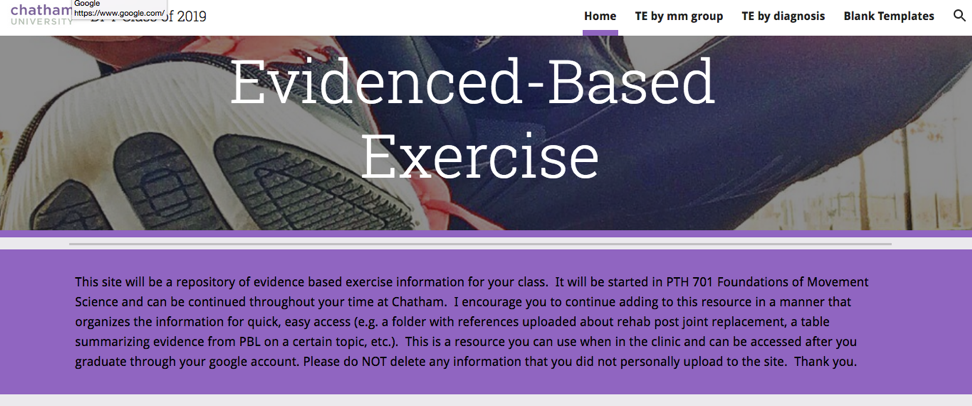
And a screenshot of a document from one of the groups: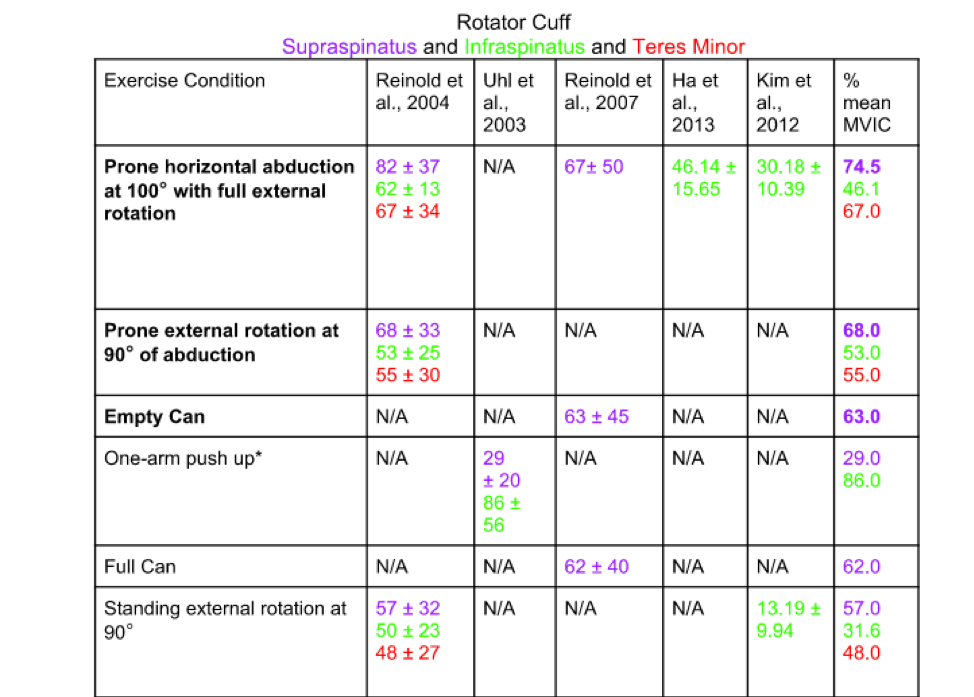
Assessment
Part 1:
I assessed student impression of the Hudl app by using the Feedback feature in Moodle. 35 out of 38 students completed the survey (they were given a few minutes at the end of the next class to complete this). The results are presented below for the second year students who used the app during Foundations of Movement Science II.
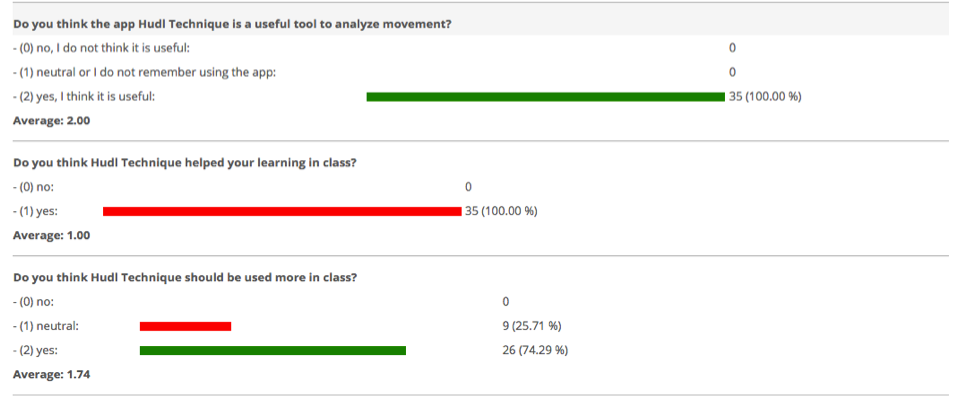
I also asked students to reflect in a free text box on what they found the most and least useful for the app. There were consistent comments that students liked being able to slow the video down to watch it, being able to rewatch as many times as needed without making a person do the movement over and over, being able to watch close up on a personal device rather than on the big screen in class. The least favorite parts of the app were that some people had a hard time getting it to work due to low memory on phones or not functioning exactly as demonstrated on an iPhone (because they had an android device) and also that we only used it once in class.
Anecdotally, several students reported seeing this app used in the clinic for running analysis with clients.
Part 2:
The same questions were asked in my second semester of use to the first year students in Foundations of Movement Science I. First year students were more ambivalent about whether this app should be used more in class than the second year group, which is interesting. Both groups thought the app was useful and helped learning. This group of students were asked about whether they liked the website where they could deposit information about exercise. Overwhelmingly, they liked this concept.
The narratives from the first years students were similar to the second years: they liked being able to slow down the video, liked having a video reference for exercises, liked being able to voice over a video to explain what was happening and slow down to watch. The least favorite things were also similar and dealt with difficulty of the technology (cannot rotate videos or cut portions out)and not being able to share as easily as they would have liked. Most students could not suggest a better website platform, although one person recommended YouTube as a better place for video storage.
Reflections and Next Steps
Hudl Technique Reflections:
- There is a time lag between sharing a video and having it show up on the app for students to see. Share video the night before it needs to be used!
- The free app does not allow more than 1 “team”… this will create a problem with each successive year because sharing a video will share it with students no longer in class. I could delete students from my team, but then they will not have access to the videos they used in class.
- The free Hudl app does not allow downloading of video that is shared (which would be a way to solve the challenge presented above). I wanted to upload video to the class’ Google site as well and cannot do that by downloading videos from the app. I could “film the film” as it is playing on my computer – but this is a time-consuming step and one I would rather avoid! There are subscription versions of the Hudl application, but there is a cost associated.
Google Site Reflections:
- Was very easy to set up
- But – you need Google drive for any pictures or documents that you are going to upload. This may lead to an eventual storage problem of my Google Drive if I continue this year after year.
Next steps:
- Determine what to do about the inability to download from Hudl Technique – either explore funding for more advanced version, look at other apps, or have students create on Hudl and then download to their computers and share via email/Google drive/youtube with me.
- Look for other ways to use movement analysis app more than once during class (need to discuss with co-instructors and instructors of other courses in our program).
- See if students as they transition to Foundations of Movement Science II like the app even more because they are familiar with it.
- Look for other ways to utilize the app in class so that the learning occurs for more than one activity.
Lilly 2017 Presenter, Joyce Salls
 Congratulations once again to Dr. Joyce Salls, Cohort 4 Tech Fellow, for being accepted to present at the June 2017 Lilly Conference on College and University Teaching and Learning! During her presentation, Using Web Based Tools to Enhance Student Engagement and Collaboration, Joyce discussed how she used free tools, such as Storify, to increase student engagement.
Congratulations once again to Dr. Joyce Salls, Cohort 4 Tech Fellow, for being accepted to present at the June 2017 Lilly Conference on College and University Teaching and Learning! During her presentation, Using Web Based Tools to Enhance Student Engagement and Collaboration, Joyce discussed how she used free tools, such as Storify, to increase student engagement.
Using Web Based Tools to Enhance Student Engagement and Collaboration – Chatham University
This presentation will demonstrate two web based tools that can be used to increase student engagement both in online and on the ground courses.
Abstract: Educators today are challenged to provide students with learning activities that promote reflective thinking via web technology. This presentation will demonstrate how two free web based tools were used to enhance student engagement, creativity, and collaboration both in online and on the ground courses. Participants will have the opportunity to explore these tools and share their own ideas of how to incorporate active learning strategies in their classroom settings.
Session Outcomes:
(1) Learn about two free web based technology tools. (2) Discuss ways to utilize web based tools
to enhance student engagement and foster collaborative learning. (3) Consider how these technologies may be implemented both in online and on the ground courses.
Thanks to Joyce for being a great example to us all!
Dr. Lou Martin – History
Project Overview
My goal has been to design the first digital humanities course for the History program, and I am teaching that course this semester. The course is titled HIS 309 Digital Local History, and in it, students learn about an aspect of local history, study some of the primary opportunities and challenges of using digital media to analyze and interpret histories, and then use available primary and secondary sources to create an online local history exhibit.
Digital Humanities has recently become an important subfield in multiple disciplines, including history. It encompasses using digital technologies in research as well as presentation of findings. In the field of history, scholars are increasingly relying on digitized texts and images in their research. More and more archivists are using optical character recognition software to translate typewritten documents of the past into searchable text for current researchers. And finally, historians and curators are creating online exhibits with the goal of stretching beyond the written word or the museum wall to online media that not only make their work more accessible to a broader audience but also incorporate new ways to visualize information and allow more user interaction.
All of this means that it is important for Chatham history students to learn about these developments, learn some of the techniques of digital humanities, and to use new skills on projects of their own. Furthermore, this is another opportunity for students to make the transition from being consumers of information to historians in their own right. Finally, this course incorporates project based learning that is typical in many museums, archives, and historical societies doing the work of digital humanities.
Planning Process
In the summer and fall of 2016 as part of the Tech Fellows program, I researched digital technologies that students might use to create an online exhibit. Lauren Panton recommended Timeline JS by Knight Lab of Northwestern University as the umbrella tool for bringing various elements of the project together. Timeline can display photographs, images, infographics, and maps as well as play audio clips. Becky Borrello recommended a variety of platforms for the website including WordPress, Weebly.com, and Wix.com as well as a storyboarding technique for web design.

I chose an online textbook by Daniel Cohen and Roy Rozenzweig titled Digital History: A Guide to Gathering, Preserving, and Presenting the Past on the Web for the students to read to learn about the challenges and opportunities of digital history as well as some of the basics of planning on online exhibit and questions historians must ask themselves http://chnm.gmu.edu/digitalhistory/

I also am having students read articles on local African American history as well as selections from David Kyvig’s Nearby History: Exploring the Past Around You. These additional readings should help to ground students in the secondary literature and give them ideas for finding primary sources.
Finally, I modeled the course schedule on a similar class being taught by one of my colleagues at Shawnee State University. Dr. Andrew Feight has been teaching a digital history course where students add to a growing digital archive of local records and photographs as well as a smartphone app that helps people explore local history. Feight uses project-based learning to encourage students to identify goals and learn the skills needed to meet the goal. The students also identify roles for themselves within the group and recognize the need for different people to have different and complementary strengths.
Implementation
The course started in January 2016 and the students spent the early weeks reading local history, learning about potential primary sources in nearby archives (including our own), and discussing their own project. This project will focus on the history of Westinghouse High School and will incorporate the school’s “Wall of Fame”—itself an effort to preserve the school’s history—as well as oral history interviews that past Chatham students have collected.
The students only recently began the process of designing the website and gathering materials. They identified roles for themselves. To start, they all decided to explore individual topics: music, sports, women, civil rights, WHS in Homewood history, and education.
At the beginning of the process, I asked students to identify values for the group from then on. They identified values such as respect for participants, respect for the past, positive stories, and commitment to the project.
I also asked the students to imagine a process to hold one another accountable and to be the basis of grades. One student recommended progress reports, and I suggested they be biweekly. Another student suggested the final project be graded on three C’s: creativity, content, and citations.
During the project gathering phase, the only grade they receive is on their biweekly reports, but they get feedback from the group on their contributions and informal presentations.
Sam Houston State University’s Center for Project Based Learning recently identified common elements of all project based learning:
- There must be the presence of a driving question or central concept.
- Students must learn through investigation of defined goals and should be constructive and knowledge building.
- Projects are student-centered with teacher facilitation or guidance.
- Projects are real-world and have significance to the student.
- There is a task, a process, a product and a reflection.
Digital Local History uses all six of these elements.
Assessment
In Digital Local History, there are three assessments of the project based learning.
The first is the feedback and grades I give on the biweekly progress reports. So far, I have based these grades on the level of effort and introspection on the reports. Students who have spent times crafting the reports, detailing significant efforts, and contemplating their results in the context of the larger project have received A’s. Students whose reports show evidence of sloppiness and superficial thought and a lack of significant efforts to gather materials have, so far, received C’s and encouragement to rediscover their passion for their topic and to fall back on skills they have read about in class.
The second feedback will be from community partners. This is a common practice in PBL, and we are scheduled to present a nearly finished product to community partners near the end of the semester. This will be an opportunity for them to comment on the project’s accuracy, creativity, and its spirit—does it capture the history of Westinghouse High School as the community understands it?
Finally, I will give the project an overall grade based on criteria suggested by a student and agreed to by the others: creativity, content, and citations.
Successes and Challenges
One of the successes has been getting the students out of the classroom and into the local archives and brining community partners to the classroom. This has made the project all the more real for the students. Students have seemed to value their interactions with people who experienced the history they are discovering. And getting in the van to take a short trip has injected some feeling of going into “the real world” to explore history.
One of the challenges has been that this particular group of students is not particularly talkative, especially not the students who are most prepared for class. This has led to stilted conversations instead of exciting brainstorming sessions.
Furthermore, one of the essential elements of PBL is to have students develop their own goals and then learn skills along the way to achieving those goals. It has been hard to get student to visualize a “desired outcome” that encourages them to learn new skills. Instead, students want me as the instructor to tell them what to do, and they want me to show them templates for them to fill in. This undermines one of the elements of PBL, but given that the students are unaccustomed to PBL and are afraid to fail, this is one of the concessions I am making.
Reflections and Next Steps
Ultimately one of the biggest challenges for me is relying on the students to deliver a finished product for community partners to see and evaluate. Like most instructors, when I am in control of the content of the course and structure the class to ensure certain outcomes, I am in my comfort zone. This course has forced me to leave the comfort zone and entrust the students with more control and has forced me to have faith that they will deliver.
Over the next month, the students will bring together their text, images, and audio, assemble them into timelines and webpages, present them to community members, and make some revisions based on community feedback.
Dr. Mary Beth Mannarino – Counseling Psychology
Project Overview
My project involved re-designing a course that had been taught for years on land for an online format. The course, PSY645 Environmental Psychology, includes exposure to such topics as climate change, ecopsychology, ecotherapy, environmental justice, and the relationship between humans and the rest of nature. It has in the past required students to engage in personal and in-class exploration of their own political, religious/spiritual, social, and environmental identities, and has necessitated thoughtful management of in-class discussions so that differences were respected and even welcomed. The primary challenge of converting the class to the online format was how best to build community online so that students could comfortably express ideas to and ask questions of the instructor and peers. A secondary task was creating an online classroom experience, through assignments and recorded lectures, that engaged students with the material, stimulated active thought, and contributed to later online forum discussions.
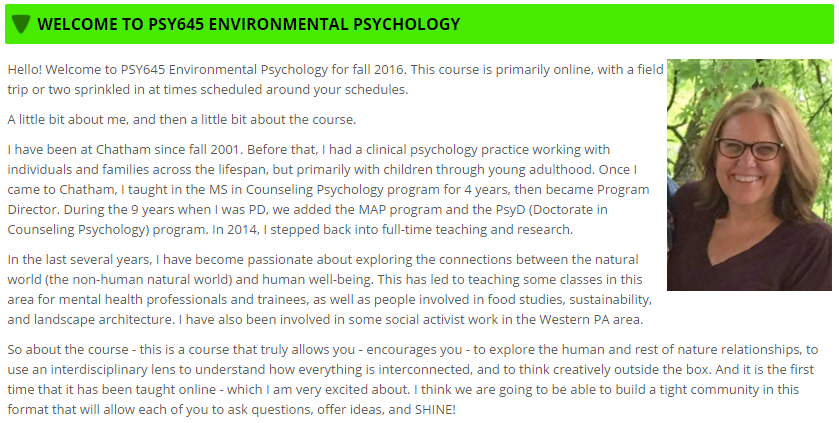
Planning Process
The course is an elective for students from several graduate programs. This class included students from two graduate programs, Masters of Science in Counseling Psychology and Masters of Food Studies. As I designed the course with a focus on the learning objectives listed below, I felt that it was important to find ways to meet the educational and professional needs of students in both programs:
- Define concepts related to environment and psychology
- Define concepts related to health and well-being
- Discuss the effects of humans on the environment, and the environment on humans, in the context of global climate change
- Reflect on and discuss own beliefs, values, and behaviors related to the above topics
- Discuss implications of topics for profession
- Discuss implications of topics for counseling and psychology roles, including assessment, treatment, prevention, and advocacy OR
- Discuss implications of topics for food studies work.
The initial steps in building the online course were as follow:
- Consultation with Lauren Panton, IT Manager, Becky Borello, Instructional Technologist, and Mark Kassel, Director of Online Education, about how best to design and structure the course on Moodle (separate from content).
- Actual design of the course on Moodle in a format that was clean, not visually overwhelming, and inviting with nature photographs.
- Planning about how to sequence the course in a deliberate way to move students through Bloom’s taxonomy from taking in and comprehending information to integrating the various topics studied across the semester to, finally, thinking about how what was studied could be applied to one’s life, personally and professionally, and creating plans for doing so.
- Careful selection of readings for the first part of the semester that addressed ways to embrace and talk across differences, and inclusion of group assignments that would foster intentional practice in doing so.
- Use of VoiceThread to create weekly PowerPoint lectures, which included links to videos and pauses for thinking and note-taking to facilitate discussion. Since the PowerPoint lectures were created week-to-week, it was possible also to integrate specific issues or comments that had been raised in the previous week’s student discussions.
NOTE: The class did include an option for a group field trip OR individual field trip; these experiences were included as a topic in a discussion forums.
Implementation
Initial planning for the project took place during Summer 2016, and the course was implemented in Fall 2016 with 14 students (12 MSCP and 2 MFS). Changes were made to course delivery throughout the semester in response to student feedback.
Below is a summary of steps taken to address the two tech goals outlined above.
The first goal was to build an online community that fostered brave and respectful discussion of issues that had political, religious/spiritual, or environmental aspects to them. The first two weeks were critical for laying this foundation, as described below.
1. Week 1 – Place Identity and Attachment – Students read articles and watched a video about place attachment and identity, and introduced themselves in a discussion forum by sharing information about and a photo of one of their own special places. This was a relatively “neutral” topic that allowed students to be creative in what they shared and to get to know something unique and personal about each other student.
2. Week 2 – Creating Brave Spaces for Learning – Two readings specifically addressing talking across differences were assigned (Parker, 2011, and Arao and Clemens, 2013, referenced below). In addition, I used VoiceThread to record a PowerPoint lecture entitled “Civil Discourse.” The lecture reviewed both articles and included specific exercises for the students to complete at home that mimicked what might be done in a classroom, but at the same time allowed greater privacy for student contemplation prior to discussion (unlike the live classroom). Examples of questions and exercises that were included in the lecture and then discussed as a group in the forum are described below:
a. Where do you stand? In the privacy of their home, each student was asked to take a large piece of paper and to mark the four corners of the paper with Likert-like ratings (Very Important, Kind of Important, Not Very Important, and Not Important at All – with Neutral in the center). They were then asked to mark where they stood with regard to the relevance of your political identity, religious/spiritual identity, social identity (including race, age, SES, gender, etc.), and environmental identity to their daily lives. I did NOT ask what the specifics associated with these identities were, only the relevance/importance of them to the person. The goal was for students to think, as they completed the exercise privately, about peers whose religious or political or other identity might be different from theirs in content but equally strong in terms of personal relevance. The exercise was designed to build empathy, thus contributing to the development of a healthy and respectful online discussion culture.
b. Think about the current election cycle (Fall 2016). Students were encouraged to apply the readings, in private, to their own experience of the current election cycle, and to think about how this was playing out in relationships, conversations, etc. Again, a goal was for the students to imagine peers who might also have strong thoughts and emotions related to the election, with different beliefs or political orientations.
c. Discussion forum – Students were asked to respond to the following prompt, and then to read and respond to several posts from peers:
-“List and discuss a couple of ideas that would contribute to the creation of a healthy ‘brave space’ discussion forum culture in our class.”
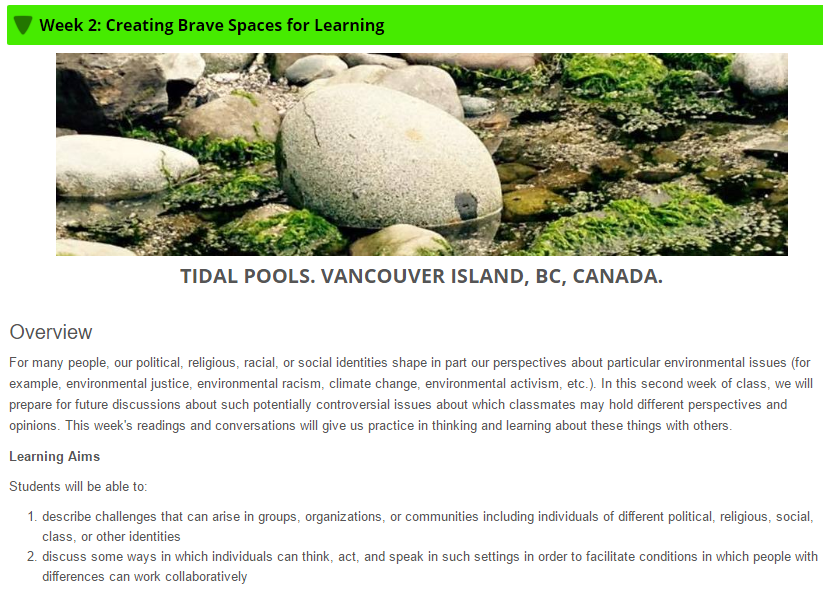
3. Throughout subsequent weeks, students were reminded to review the discussion and readings from Week 2 as they tackled talking about challenging topics.
The second goal was to learn how to create an online class experience that actively engaged students. To do this, I included questions and exercises throughout the PowerPoint lecture that required the students to pause and DO something that would then be incorporated into the discussion forum (as described above). I also embedded videos of varying lengths into the lectures. Finally, the course material included links to online sites that required active exploration, in addition to traditional peer-reviewed academic articles.
Assessment
The project was assessed through an anonymous survey monkey questionnaire focusing on the online delivery process (administered a couple of weeks before the end of the course), the regular Chatham-administered course evaluations, and a final discussion forum requiring students to describe their “3 Take-Aways” from the course. In addition, comments and suggestions were invited throughout the course. Below is feedback from the assessments.
SURVEY MONKEY (9/14 responded)
1. Have you taken an online graduate level course before?
YES 11%
NO 89%
2. Rate your degree of ease in navigating Moodle for getting information about assignments and making your posts and comments.
Very Easy 44.44%
Pretty Easy 33.33%
So-So 22.22%
Kind of Difficult 0
Impossible 0
3. How comfortable did you feel sharing your opinions and ideas with your classmates?
Very Comfortable 44.44%
Pretty Comfortable 55.55%
So-So 0
Kind of Uncomfortable 0
Very Uncomfortable 0
4. What suggestions do you have for improving the online course delivery process? (SUMMARY OF RESPONSES)
- More specific training in tech aspects of class
- Better posting schedule – posting 3x week was challenging, especially when due on weekends
- Have first class in–person
5. Describe least favorite part(s) of course. (SUMMARY)
- Schedule of posts
- Back and forth nature of posts and comments – sometimes confusing
- Required too much time – wish it had been in-person
6. Describe favorite parts of the course. (SUMMARY)
- Able to get into issues in a way that wouldn’t have been able to in person
- Variety of materials – readings, videos, internet resources
- News item discussions (based on a particular assignment)
- Opportunities for discussion with other students
- Course topics and content
7. Any surprises for you in the course? (SUMMARY)
- Amount of time required for online course
- What I learned from content of course
- Learned more than in in-class course because of in-depth discussions and time to think before “speaking”
ADDITIONAL INFORMATION FROM ASSESSMENTS AND EVALUATIONS
The formal Chatham course evaluation comments were consistent with those summarized above.
In addition, students completed a final discussion forum related to their “3 Take-Aways” from the class. Below are some comments that are related to the goals of this project:
- I have rediscovered and even improved my critical thinking skills as a result of this class. (I’m not sure my husband is happy about this. LOL…) I am able to look at events, debates, studies, and see even more angles to what I am analyzing. It has helped me through this election as well as not to argue with people. This is very beneficial to my counseling skills because it also allows me to see more process that is going along with the content.
- I will also remember the conversation we had about brave spaces vs safe spaces. For some reason, I always thought of the therapy space being safe, but I was neglecting the idea of the space being one where clients feel brave enough to take the next step, or to help to become brave so they can use that quality in their everyday lives.
- The first major take away that I would like to talk about is the fact that we, as a class, were able to work and learn together. We formed an online Chatham community where I was able to learn more from everyone’s contributions than the material itself. I had never taken an online class before and although it’s not my personal favorite style of learning, this was a great experience! I really felt that the creating brave spaces in week two helped contribute to this style of learning.
- I enjoyed the non-traditional format of this course. I felt like I was able to learn more without relying on one textbook, and was offered many different perspectives on environmental psychology within the readings. I also enjoyed that we were able to have thoughtful in depth conversations through the online discussion boards.
Finally, I was able to do informal comparisons of this online class with the many previous times the course was taught in a traditional on land format. First, I heard substantively from every student in every session throughout the semester; in the “live” classes, in spite of my efforts to draw quiet people out, certain students stayed in the background during most of the discussions and did not express ideas that, based on my online experience, might have contributed significantly to the larger discussion. Second, the ideas discussed in the online forums were more thoughtful and detailed than most of those in the on land class; I believe that the chance to think things through privately before posting allowed for careful deliberation of both what to say and how to say it. And third, the requirement that students “talk” to each other in the discussion forums resulted in very respectful and personalized responses. While I weighed in on the discussions, the discussions were really conversations between the students themselves; sometimes it seemed like my own posts were superfluous! This was very different from the traditional format where so many comments, even if I tried to redirect them, were from the students to me rather than to each other.
Fourth, knowing that the online class lacked the energy of the actual students’ presence during the lectures, I needed to make sure there was great variety of materials for students to review each week and thus expanded readings with more internet sites and videos than I had used in the traditional format. I think this helped students stay engaged, and appealed to different ways of learning.
Finally, I want to note a change that I made in course expectations mid-semester. I assigned lots of readings each week. In reviewing early student discussions, I could tell that not every student read every assigned article (which I am sure happens in on land classes as well! It is just harder to track). I had a couple of choices: 1) I could decrease the number of readings and hold students accountable for reading all of them through a grading process, or 2) each week, I could continue to assign multiple readings, videos, etc., and even expand the number of offerings related to the week’s topics, and allow students to choose what to read. The second choice felt less conventional but more attractive to me, as an experiment, so I took it. The result was that – while not everyone reviewed everything, everything was reviewed and posted about by someone, AND students read posts about things they had not chosen to read, learned something, and contributed to the discussion. What I personally liked about this option was that it allowed me to post LOTS of interesting material each week that might otherwise, in an on land class, not get presented; I think the students were thus exposed to more material through the discussions.
Reflections and Next Steps
I was satisfied with this first offering of the online version of PSY645 Environmental Psychology, and with the outcomes for the project. First, I believe that the efforts to structure the course with careful sequencing, specific readings, and a focused lecture on “Civic Discourse” contributed to the students’ abilities to tackle challenging material and to discuss it with peers both bravely and respectfully. I also believe that this experience is one that many students will carry with them into their professional and personal lives. Second, most students seemed to appreciate the multiple formats in which information was presented.
I enjoyed learning how to present an online class and hearing from students about ways to make the process even better. I will be teaching the course again in a six week format during Summer 2017 and will make a few changes in it, including the following:
- I will provide more instruction in online/tech processes at the start.
- I will be more thoughtful about the posting schedule, particularly since students will be doing two class sessions per week.
- I will do a weekly individual check-in with each student via email.
- I will do also quick surveys each week about how the class is going, so that I can make adjustments in terms of pace, content, and load.
- I will be intentional at the outset about the “I am offering scads of material for you to review each week; you must read X and you can choose among the other materials” format.
- I will continue to offer a field trip (group or individual) activity.
References
Arao, B., and Clemens, K. (2013). From safe spaces to brave spaces: A new way to frame dialogue around diversity and social justice. In L. Landreman (ed.), The art of effective facilitation: Reflections from social justice educators (pp. 135-150). Sterling, VA: ACPA
Palmer, P. (2011). Healing the heart of democracy: The courage to create a politics worthy of the human spirit. San Francisco, CA: Jossey-Bass.
Dr. Sarah Jameson – Physical Therapy
Project Overview
My project goal is to redesign a class on the health effects of climate change using a flipped classroom model. I have created a self-directed learning unit that the students will complete before class. The in-class application exercise will use Bubbl.us concept mapping to demonstrate important relationships between the environmental consequences of climate change and human health. Concept mapping is a metacognitive process that involves making decisions about different ways concepts are related to each other and leads to a deeper understanding of the problem.
Planning Process
The class I am targeting is a first semester cohort class of 40 students. I chose topic of climate change and health because it builds understanding of an important national health issue. It also connects the DPT students to sustainability, a foundational part of the Chatham University mission.
For some of the students, the topic of climate change is controversial. In the case of controversy, a simple one-way transmission of facts is sometimes met with resistance. I hope to mitigate students’ ideological resistance by doing two things. First, in allowing students choice from a menu of source of information, I hope to reduce the tendency to categorically reject ideas that are inconsistent with old beliefs. Second, the flipped classroom model will give the students’ time to reflect on the readings and videos before entering into discussion with their peers. Time to reflect on the material should make students more comfortable and confident when engaging in discussion.
I chose learning objectives that fall into the Synthesis level of Blooms taxonomy. One of the fundamental jobs of a health scientists is to evaluate evidence and make informed decision based on scientific analysis. Students will practice critical decision making throughout the DPT curriculum.
Learning objectives:
1. Students will conclude that climate change is a product of human actions and has a deleterious effect on human health.
2. Students will propose relationships between climate change mitigating actions and corresponding impacts on human health.
Implementation
The class described is planned for fall 2017. Students will be given the flipped classroom assignment on a Wednesday and the discussion will follow the next Wednesday.
Pre-class activity
Students will choose from a menu of TED talks, research articles and quality web sites for background information about climate change and health. After completing the learning unit, students will create a concept map illustrating the relationship between climate change and health, using a free program called Bubbl.us.
Sample:
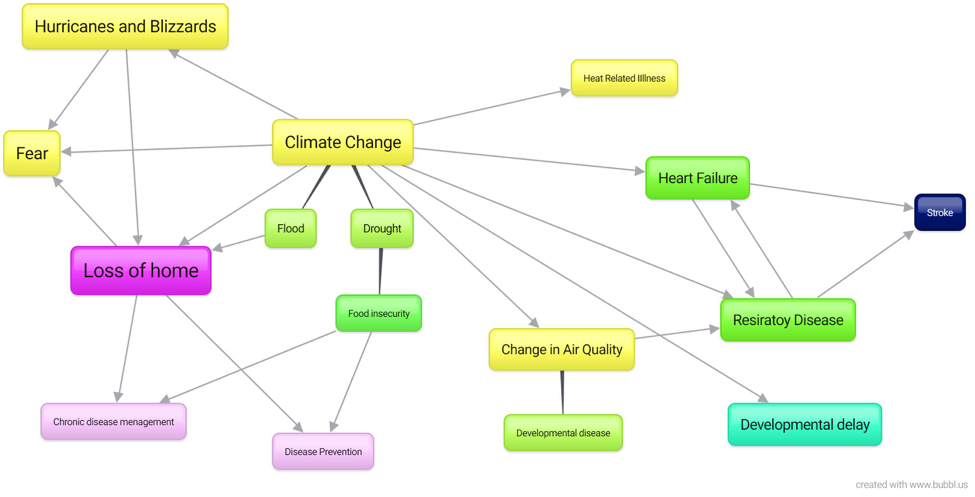
In-class activity
The class will be divided into 6 groups and tasked to devise a consensus concept map diagraming the relationships between climate change and health. Students will not have read all of the same material so they bring different perspectives to the discussion. They will compare and combine individual concept maps into a single conceptualization. These group concept maps will be uploaded to the class Moodle site for view and discussion by the class as a whole.
Finally, students will regroup to create a new concept map showing the relationship between potential climate-mitigating actions and health. This activity again draws from the students’ preparation but it is not part of the preparation prompt. Students will have to synthesize and theorize based on their understanding of the videos and reading.
Sample:

Assessment
Before the unit begins I plan to administer a survey that asks students about their beliefs and attitudes about climate change. I have permission from Gallup Polls to use the poll from Politics March 25, 2015 “U.S. Views on Climate Change Stable after Extreme Winter”. This is the most recent Gallup Poll that asks a large diverse sample about climate change beliefs and attitudes. I plan to repeat the survey at the end of the second class to see if there have been any changes in student attitudes or beliefs about climate change and health. I will also compare the cohorts’ responses to those detailed in the national Gallup Poll survey.
Reflections and Next Steps
This project has helped inform my teaching well beyond the class redesign. Becky Borello and Lauren Panton are gifted technology mentors. My fellow Fellows have inspired and mentored me as well. I owe a particular debts to Meigan Robb for helping me understand Bubbl.us and to Mary Beth Mannarino for helping to understand how to “talk across differences” when dealing with climate science.
My next target for redesign is a class on health inequity. I also plan to apply what I learned in the project, flipping the classroom and implementing concept mapping to demonstrate the complex relationships between health and wealth.
Dr. Michelle Doas – Nursing
Project Overview
This project involved integrating SWAY technology into NUR 407, a course in the RN-BSN program. NUR 407 introduces registered nurses to the research process. The formal research process is foreign to most students in the program. Thus, a main goal was to bring specific research concepts and principles down the ladder of abstraction, by integrating connections into clinical practice. These types of connections can assist students in seeing how the research process can be applied to daily professional practice.
Planning Process
NUR 407 is an online course offered over a seven week session. In this particular course, professional experience as a registered nurse was between 1-2 years. Additionally, for some students this was one of the first courses taken in the program, for others it was a course taken towards the end of the program. Therefore, I considered which type of technology could meet the primary goal along with not being overwhelming to the student.
A variety of technologies to augment online learning were assessed for appropriateness and user friendliness. It was determined that SWAY met these criterion. The SWAY interface revolves around a storyline (selected by the user), into which users add a series of cards. Each of these are cards are filled with content that is applicable to the storyline. Various cards are available for different types of content and can be grouped together into sections. Content intended to be the user’s narrative can be easily rearranged, deleted or adapted. This flexibility allows stories, based upon educational content to be created in SWAY. This approach is readily adapted, efficient and free-flowing. It can serve as an alternative to PowerPoint presentations. Unlike PowerPoint, there is no option for creating content in SWAY itself. Content must be uploaded into the software as it’s intended to be used or it can be pulled directly from different sources from within SWAY. Current sources include You Tube, Facebook and Flickr.
Implementation
To integrate SWAY into the course, I reviewed course content that was less familiar/more abstract in order to integrate SWAY accordingly. I then identified relevant topics, searched the literature, and developed a SWAY. Additionally, a Bubbl.us (concept mapping) exercise and Survey Monkey (assessment purposes) were built into the SWAY. I did a brief introduction of each technology piece and encouraged students to reach out with questions. In order to use Bubbl.us, students had to create an account, which had no associated costs.
Assessment
Assessment was conducted by integrating a brief Survey Monkey questionnaire within SWAY. The majority of students rated SWAY and associated tools, i.e. Bubbl.us as positive learning tools. Likewise, the majority of students had never been exposed to these types of technology.
Students expressed an appreciation for doing something “visual” that assisted in clarifying meaning of abstract content. Additionally they were able to make connections between abstract research concepts and daily clinical practice. During the latter part of the course, students revisited SWAY content and commented on its effectiveness in meeting course objectives and overall learning.
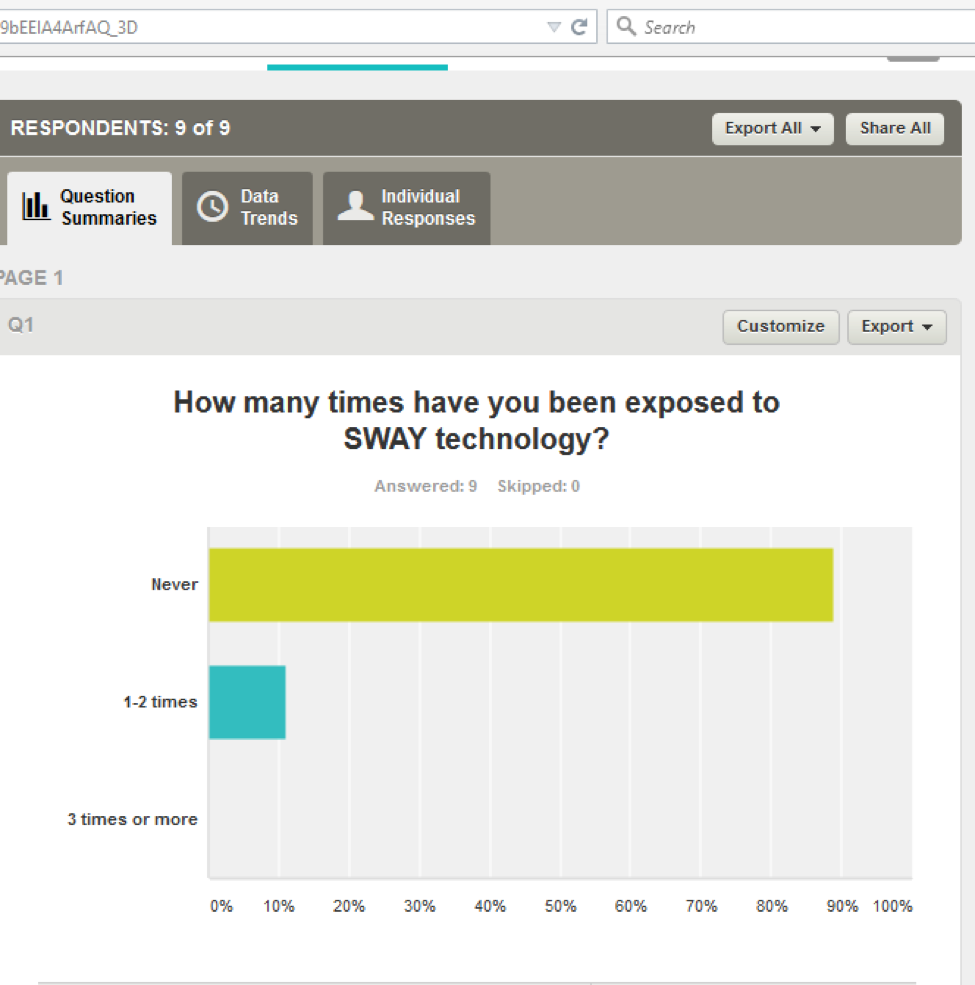
Student Feedback 1
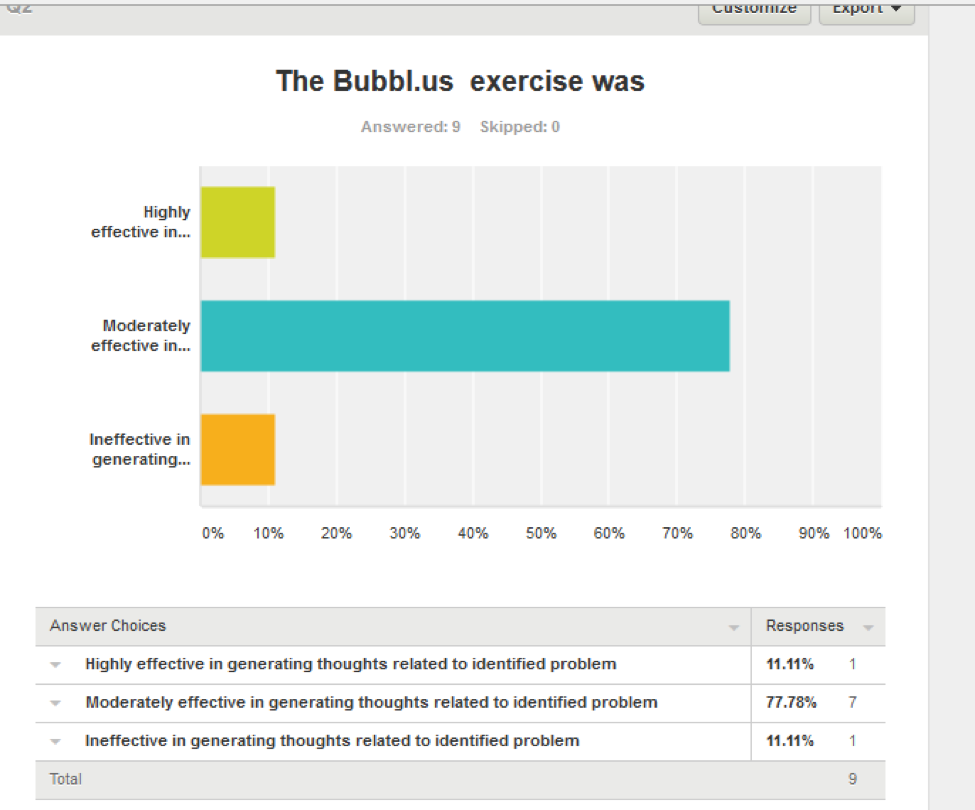
Student Feedback 2
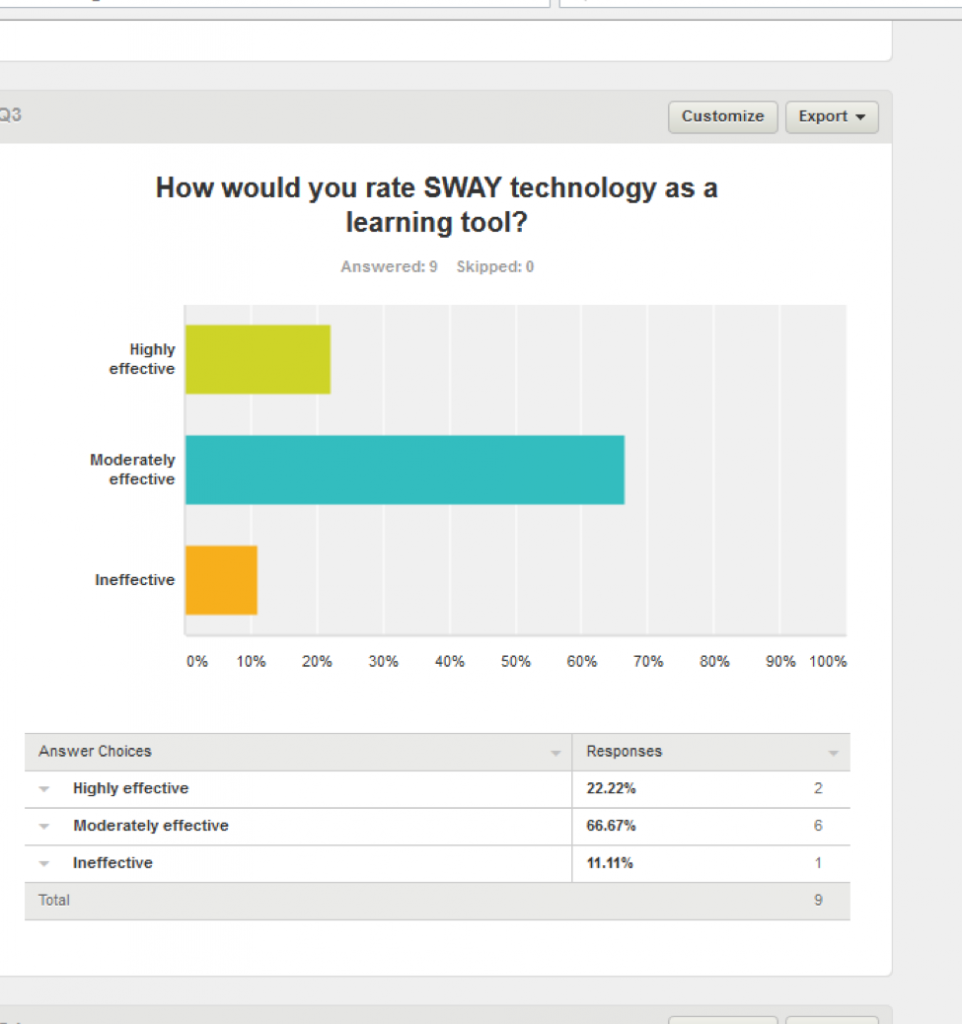
Student Feedback 3

Student Feedback 4
Reflections and Next Steps
I plan to more fully integrate SWAY into graduate nursing courses, as applicable. The wide array of topics, visuals, and technologies that can be integrated into SWAY make it a viable technology for both undergraduate and graduate level courses. The user friendliness, ability to engage students and overall creative approaches make it a highly useful tool. Additionally, its usefulness allows for creatively highlighting specific educational content. I will continue to integrate both Bubbl.us and Survey Monkey into future SWAY presentations.
Dr. Jill Cyranowski – Counseling Psychology
Project Overview
One of my tech fellow goals was to use technology to better facilitate the multiple learning styles of students taking my Advanced Data Analysis class. Research statistics can engender a good deal of anxiety for students. Math anxieties are common, and can lead to patterns of procrastination and avoidance when learning research design and statistics. As a psychologist, part of my teaching process includes finding ways to “demystify” complex processes and to address students’ level of anxiety at each step of the learning process. By breaking learning into small pieces, using repetition across a variety of learning methods, and assigning lots of weekly homework assignments, the course provides many “graded exposure” experiences, where students can, over time, master their anxiety of statistics and (at least for some!) start to take pleasure in the process.
For the current project, I wanted to try to incorporate brief SPSS tutorials into my Moodle shell, using both Atomic Learning (24/7 Technology Training) modules and some of my own brief tutorials developed using Panopto with direct screen capture of me conducting (and narrating) specific SPSS analyses. This technology would allow students, whose anxiety can interfere with memory consolidation during class, to go back to review how to implement basic SPSS procedures and analyses on their own time. In addition to my own lectures that incorporate conceptual discussion and marked-up static screen captures of SPSS outcomes, I thought that these tutorials would be a helpful addition for students who have difficulty following (or remembering) how analyses were conducted during classes.
Planning Process
As part of my planning process, I conducted a brief survey of students at the outset of my spring Advanced Data Analysis course. Survey questions included information about the students’ previous training in both research design and statistics, and their feelings about these previous courses. These data suggested that, in general, they had found their previous learning to be on a “pretty superficial level” and their previous experience of learning to be, on average, “tolerable, but not terribly interesting.” When asked to rate their current level of anxiety and enthusiasm about learning about research design and statistics, they generally rated themselves as more anxious than enthused.
In addition, I queried the students regarding their preferred methods of learning when it comes to research methods and statistics (see below). On average, the group showed a preference for working through problems as part of a larger group discussion and feedback session, with the lowest ratings for straight lectures about research concepts. They also expressed a mild preference for watching the instructor run/interpret analyses live in class (as opposed to watching videos of the instructor), and both of these methods were preferred above watching other internet tutorials. When discussed in class, students clarified that they would find brief instructor-led video tutorials to be helpful, but only as an addition to live classroom demonstrations, rather than in place of live sessions.
Implementation
I have started implementation this semester. At the beginning of the semester, a number of brief Atomic Learning tutorials were posted to Moodle, most with the goal of aiding those students with little to no previous SPSS experience to become familiar with basic data manipulation and cleaning procedures. In addition, I have played with developing my own tutorials in Panopto, posting the first one on how to run moderation analyses in SPSS. More of these videos will be posted in the next section of the class covering ANOVA analyses, with formal assessments from students to be conducted at the end of the class.
Assessment
Despite the “mean level” preferences reported in the above graph regarding student learning preferences, I was struck by the stark differences reported by different students with respect to their preferred modes of learning. This makes me think that continuing to incorporate multiple media approaches to learning will be the way to go, in order to enhance learning experiences across a range of different learners. It will also be interesting to see if the students’ preferred learning strategies and/or levels of anxiety or enthusiasm for the material changes at all following completion of the class.
Formal assessments from students will be collected at the end of this spring term class. Informally, I’ve found that that not all of the Atomic Learning videos are great, so it does take some time to find the tutorials that will be most helpful for student learning. I’ve also learned the importance of maintaining consistency when selecting and/or developing on-line tutorials of basic procedures that we cover in class. While you can often find a number of ways to run the same basic procedures in SPSS, early learners of the software get confused if you introduce too many options too early in the learning process. I’ve also learned that it is unlikely that I will do away with running most all analyses together in class (in a format where students can ask questions and talk through the process, and in which we can interpret outputs together as a group). Indeed, when I floated the idea of only posting some taped tutorials (which do supplement both book procedures and my lecture slides), there was mild panic from the class.
Reflections and Next Steps
This semester, I will work to develop a few more basic tutorials based on the basic ANOVA analyses we will be running in class. I also plan to go through additional Atomic Learning modules covering basic Regression and ANOVA procedures. I will retest the group at the end of the course, and will use those data to inform further modifications to the class for next year.
